Paul van Yperen's Blog, page 451
July 8, 2013
John Loder
Tall and handsome John Loder (1898-1988) was best known for wearing tweeds and smoking a pipe in his roles. The British-American actor started his film career as an extra in the German silent cinema, and later worked as a leading man both in Great Britain and in Hollywood.
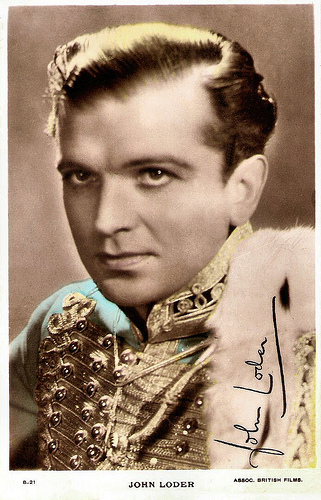
British postcard by Real Photograph, no. B 21. Photo: Assoc. British Films.
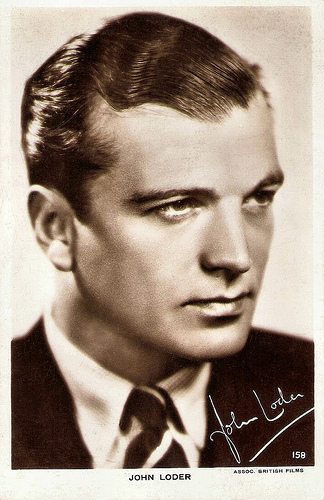
British postcard by Real Photograph, no. 158. Photo: Assoc. British Films.
Popular Heartthrob
John Loder was born William John Muir Lowe in London in 1898. His father was General W. H. M. Lowe, the British officer to whom Patrick Pearse, the lead rebel of the 1916 Easter Rising in Dublin, Ireland, surrendered. John was educated at the prestigious Eton college and at the Royal Military College. He followed his father into the army, being commissioned into 15th Hussars as a second lieutenant in 1915, and then served in the Gallipoli Campaign. In France, he was engaged in the Battle of the Somme and was taken prisoner by the Germans in 1918 and brought to a prisoner-of-war camp in Germany. After leaving the cavalry he established a pickle factory in Potsdam. Loder also began to develop an interest in acting. He appeared in bit-parts in a few silent German films at the Tempelhof Film Studios, employed by Alexander Korda. Examples are the comedy Der Tänzer meiner Frau/Dancing Mad (Alexander Korda, 1925) starring Victor Varconi and María Corda, and Madame wünscht keine Kinder/Madame Wants No Children (Alexander Korda, 1926) starring María Corda and Harry Liedtke. He had bigger roles in Die weiße Spinne/The White Spider (Carl Boese, 1927) with Maria Paudler, and the horror fantasy Alraune/Mandrake (Henrik Galeen, 1928) starring Brigitte Helm. Loder returned to England, where he played a big role in the silent drama The First Born (Miles Mander, 1928) starring Madeleine Carroll. It was made by Gainsborough Pictures at their Elstree Studios. Talkies had become the new rage and Loder tried his luck in Hollywood. He appeared in The Doctor's Secret (William C. De Mille, 1929), which was Paramount's first talking picture. He was also in Rin-Tin-Tin's first sound picture, in 1930. Gary Brumburgh at IMDb : “although the ‘veddy British’ actor seemed to show promise, his persona was a bit too cut and dried for American tastes. Gaining little ground as a leading man there, Loder eventually returned to England“. He played a supporting part in Hitchcock’s second sound film, Juno and the Paycock (Alfred Hitchcock, 1930) and another in the historical comedy The Private Life of Henry VIII (Alexander Korda, 1933) starring Charles Laughton as Henry VIII, King of England. He became a popular heartthrob with such plush musicals as Love Life and Laughter (Maurice Elvey, 1934) with Gracie Fields. He co-starred with Sylvia Sidney and Oscar Homolka in Hitchcock’s thriller Sabotage (Alfred Hitchcock, 1936), based on Joseph Conrad's novel The Secret Agent. Loder was also the male romantic interest in the original King Solomon's Mines (Robert Stevenson, 1937), the first film adaptation of the novel by Henry Rider Haggard.
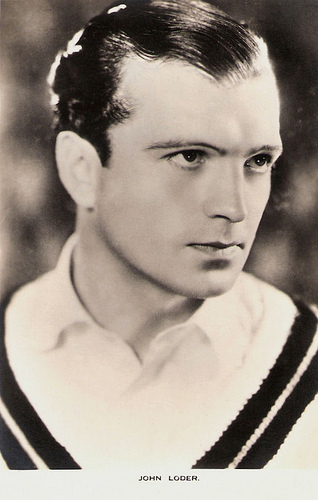
British postcard in the Film Weekly Series, London.
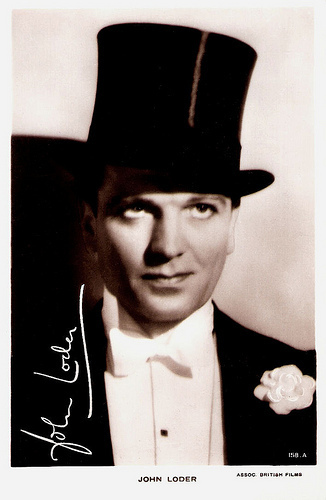
British postcard by Real Photograph, London, no. 158 A. Photo: Gaumont-British.
A Career in B Movies
When World War II started, John Loder returned to America. In Hollywood he seamlessly coasted into a career in B movies, usually playing aristocrats. Occasionally he played supporting parts in major A films such as How Green Was My Valley (John Ford, 1941), Now, Voyager (Irving Rapper, 1942) with Bette Davis, and Passage to Marseille (Michael Curtiz, 1944) starring Humphrey Bogart. In Hollywood, Loder never attained the star status he had enjoyed in Britain during the 1930s. He was married five times. His first wife was Sophie Kabel, with whom he had a son. Two of his wives were actresses: French actress Micheline Cheirel (1936–1941), with whom he had a daughter, and Hollywood love goddess Hedy Lamarr (1943–1947). With Lamarr, he had two children, Denise (1945) and Anthony (1947), and adopted Lamarr's son James Markey from her previous marriage to screenwriter Gene Markey. He co-starred with her in the American crime drama Dishonored Lady (Robert Stevenson, 1947), which Lamarr produced. He also appeared on Broadway in 1947 and 1950. In 1947 he became an American citizen, and two years later, he married wife no. four, Evelyn Auff Mordt (1949-1955). Incidentally he appeared in films, like Gideon's Day (John Ford, 1958) featuring Jack Hawkins. In 1958, he also wed his final wife, Argentine heiress Alba Julia Lagomarsino, and Loder semi-retired. He lived on her 25,000 acre cattle ranch, and spent much time at the Jockey Club in Buenos Aires. In 1959 he became a naturalised citizen of the United Kingdom as he had been of ‘uncertain nationality’. His last screen appearance was in the British crime film The Firechasers (Sidney Hayers, 1971) starring Chad Everett. After divorcing his fifth wife in 1972, Loder returned to London and resided for some years in a house opposite Harrods. His general health deteriorated in his eighties and he was admitted in 1982 to the Distressed Gentlefolks Aid Association's Nursing Home in Kensington, where he was well looked after, venturing out by taxi once a week to his Club for luncheons. John Loder eventually died in London, aged 90 in 1988. His autobiography, Hollywood Hussar was published in 1977.
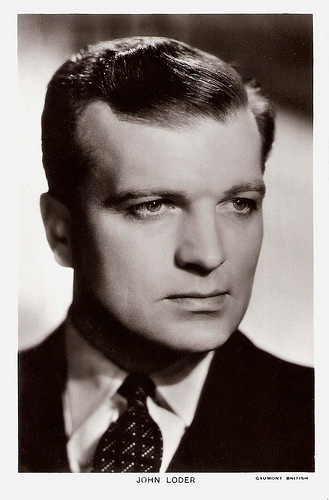
British postcard by Real Photograph in the Picturegoer Series, London, no. 419c. Photo: Gaumont-British.
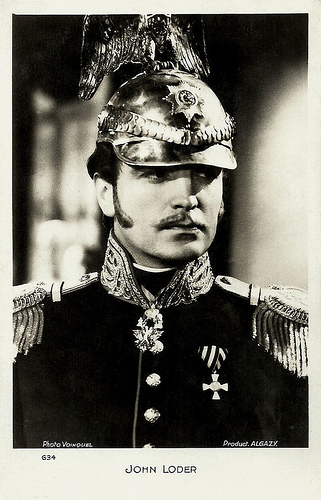
French postcard by Algazy, no. 634. Photo: Voinquel. Probably a card for Maurice Tourneur's period piece Katia (1938), in which the Russian Czar Alexander II (Loder) turns his mistress Katia (Danielle Darrieux) into a princess, which eventually leads to his assassination.
Sources:

British postcard by Real Photograph, no. B 21. Photo: Assoc. British Films.

British postcard by Real Photograph, no. 158. Photo: Assoc. British Films.
Popular Heartthrob
John Loder was born William John Muir Lowe in London in 1898. His father was General W. H. M. Lowe, the British officer to whom Patrick Pearse, the lead rebel of the 1916 Easter Rising in Dublin, Ireland, surrendered. John was educated at the prestigious Eton college and at the Royal Military College. He followed his father into the army, being commissioned into 15th Hussars as a second lieutenant in 1915, and then served in the Gallipoli Campaign. In France, he was engaged in the Battle of the Somme and was taken prisoner by the Germans in 1918 and brought to a prisoner-of-war camp in Germany. After leaving the cavalry he established a pickle factory in Potsdam. Loder also began to develop an interest in acting. He appeared in bit-parts in a few silent German films at the Tempelhof Film Studios, employed by Alexander Korda. Examples are the comedy Der Tänzer meiner Frau/Dancing Mad (Alexander Korda, 1925) starring Victor Varconi and María Corda, and Madame wünscht keine Kinder/Madame Wants No Children (Alexander Korda, 1926) starring María Corda and Harry Liedtke. He had bigger roles in Die weiße Spinne/The White Spider (Carl Boese, 1927) with Maria Paudler, and the horror fantasy Alraune/Mandrake (Henrik Galeen, 1928) starring Brigitte Helm. Loder returned to England, where he played a big role in the silent drama The First Born (Miles Mander, 1928) starring Madeleine Carroll. It was made by Gainsborough Pictures at their Elstree Studios. Talkies had become the new rage and Loder tried his luck in Hollywood. He appeared in The Doctor's Secret (William C. De Mille, 1929), which was Paramount's first talking picture. He was also in Rin-Tin-Tin's first sound picture, in 1930. Gary Brumburgh at IMDb : “although the ‘veddy British’ actor seemed to show promise, his persona was a bit too cut and dried for American tastes. Gaining little ground as a leading man there, Loder eventually returned to England“. He played a supporting part in Hitchcock’s second sound film, Juno and the Paycock (Alfred Hitchcock, 1930) and another in the historical comedy The Private Life of Henry VIII (Alexander Korda, 1933) starring Charles Laughton as Henry VIII, King of England. He became a popular heartthrob with such plush musicals as Love Life and Laughter (Maurice Elvey, 1934) with Gracie Fields. He co-starred with Sylvia Sidney and Oscar Homolka in Hitchcock’s thriller Sabotage (Alfred Hitchcock, 1936), based on Joseph Conrad's novel The Secret Agent. Loder was also the male romantic interest in the original King Solomon's Mines (Robert Stevenson, 1937), the first film adaptation of the novel by Henry Rider Haggard.

British postcard in the Film Weekly Series, London.

British postcard by Real Photograph, London, no. 158 A. Photo: Gaumont-British.
A Career in B Movies
When World War II started, John Loder returned to America. In Hollywood he seamlessly coasted into a career in B movies, usually playing aristocrats. Occasionally he played supporting parts in major A films such as How Green Was My Valley (John Ford, 1941), Now, Voyager (Irving Rapper, 1942) with Bette Davis, and Passage to Marseille (Michael Curtiz, 1944) starring Humphrey Bogart. In Hollywood, Loder never attained the star status he had enjoyed in Britain during the 1930s. He was married five times. His first wife was Sophie Kabel, with whom he had a son. Two of his wives were actresses: French actress Micheline Cheirel (1936–1941), with whom he had a daughter, and Hollywood love goddess Hedy Lamarr (1943–1947). With Lamarr, he had two children, Denise (1945) and Anthony (1947), and adopted Lamarr's son James Markey from her previous marriage to screenwriter Gene Markey. He co-starred with her in the American crime drama Dishonored Lady (Robert Stevenson, 1947), which Lamarr produced. He also appeared on Broadway in 1947 and 1950. In 1947 he became an American citizen, and two years later, he married wife no. four, Evelyn Auff Mordt (1949-1955). Incidentally he appeared in films, like Gideon's Day (John Ford, 1958) featuring Jack Hawkins. In 1958, he also wed his final wife, Argentine heiress Alba Julia Lagomarsino, and Loder semi-retired. He lived on her 25,000 acre cattle ranch, and spent much time at the Jockey Club in Buenos Aires. In 1959 he became a naturalised citizen of the United Kingdom as he had been of ‘uncertain nationality’. His last screen appearance was in the British crime film The Firechasers (Sidney Hayers, 1971) starring Chad Everett. After divorcing his fifth wife in 1972, Loder returned to London and resided for some years in a house opposite Harrods. His general health deteriorated in his eighties and he was admitted in 1982 to the Distressed Gentlefolks Aid Association's Nursing Home in Kensington, where he was well looked after, venturing out by taxi once a week to his Club for luncheons. John Loder eventually died in London, aged 90 in 1988. His autobiography, Hollywood Hussar was published in 1977.

British postcard by Real Photograph in the Picturegoer Series, London, no. 419c. Photo: Gaumont-British.

French postcard by Algazy, no. 634. Photo: Voinquel. Probably a card for Maurice Tourneur's period piece Katia (1938), in which the Russian Czar Alexander II (Loder) turns his mistress Katia (Danielle Darrieux) into a princess, which eventually leads to his assassination.
Sources:
Published on July 08, 2013 23:00
July 7, 2013
Jean-Paul Belmondo
One of our favorite French stars is Jean-Paul Belmondo (1933). Bébel was a big comedy and action star in Europe from the mid-1960s till the mid-1980s, but he was initially associated with the Nouvelle Vague, the French New Wave of the 1960s. Despite his unconventional looks, including a broken nose, he was often polled as one of the sexiest men in the world. For some 50 years he now remains one of the most popular and best-loved personalities in France.
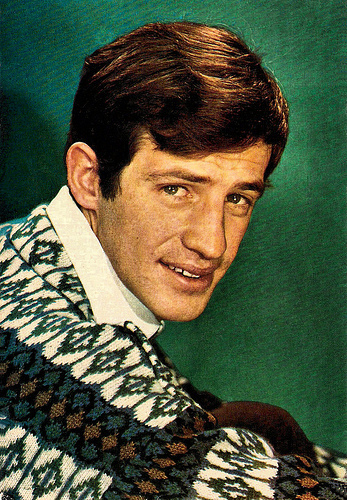
Spanish postcard by Oscarcolor, Barcelona, no. 83, 1964. Photo: Sam Lévin.
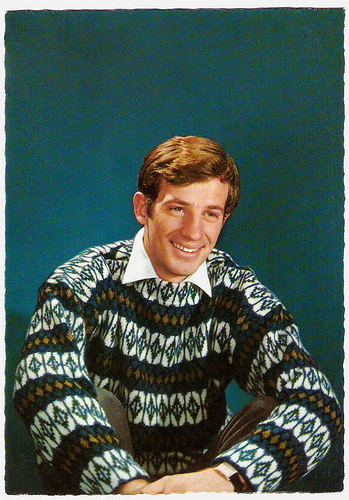
French postcard by E.D.U.G., no. 160. Photo: Sam Lévin.
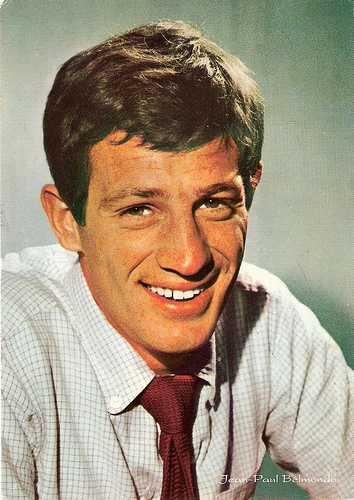
Italian postcard in the series Artisti di sempre by Rotalfoto, Milano, no. 355.
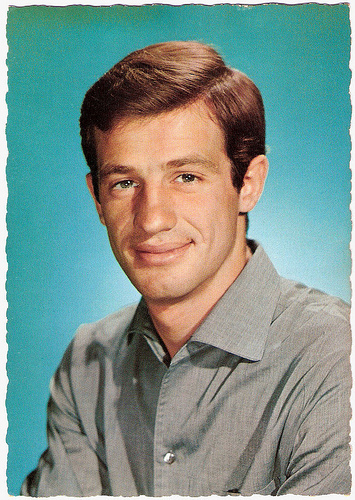
French postcard by E.D.U.G., no. 77. Photo: Lucienne Chevert.
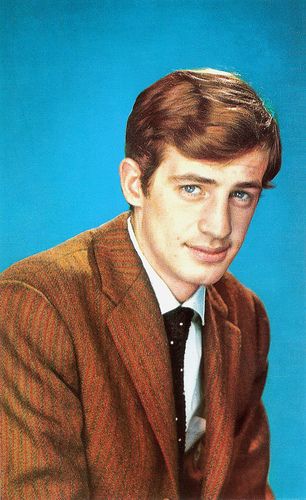
French postcard by Editions P.I., Paris, no. 1065, presented by Corvisart, Epinal. Photo: Sam Lévin.
Bébel
Jean-Paul Belmondo was born in Neuilly-sur-Seine, a commune in the western suburbs of Paris, in 1933. He is the son of Paul Belmondo, a sculptor of Sicilian descent. Young Jean-Paul did not perform well at school, but developed a passion for boxing before he decided that his future lay in acting. After a number of attempts, he finally gained admittance to the Paris Conservatoire in 1952, although his tutors were not overly optimistic about his prospects. It was here that he acquired the nickname 'Bébel'. In the mid-1950s, he appeared in a few theatrical productions, often to great acclaim, before beginning a film career in 1956 with Les Copains du dimanche/The Sunday Friends (Henry Aisner, 1956-1958). The film was never played in public cinemas though and his episodes in À pied, à cheval et en voiture/On Foot, on Horse, and on Wheels (Maurice Delbez, 1957) were even cut before release, but soon bigger roles followed in the spoof thriller Sois Belle et Tais-Toi/Be Beautiful But Shut Up (Marc Allégret, 1957) - his first co-starring role with Alain Delon, the hit Les Tricheurs/The Cheaters (Marcel Carné, 1958) and À double tour/Web of Passion (Claude Chabrol, 1959) with Madeleine Robinson. It was in 1958 that the 25-year-old Belmondo attracted the attention of a former critic turned filmmaker Jean-Luc Godard. The latter was impressed by the actor’s spontaneity and cast him first in a quirky short, Charlotte et son Jules (1959).
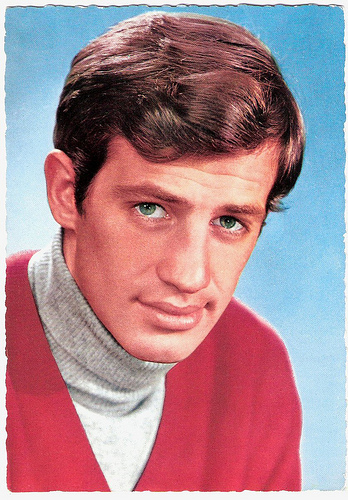
French postcard by E.D.U.G., nr. 233. Photo: Sam Lévin.

French postcard by E.D.U.G., nr. 78. Photo: Lucienne Chevert.
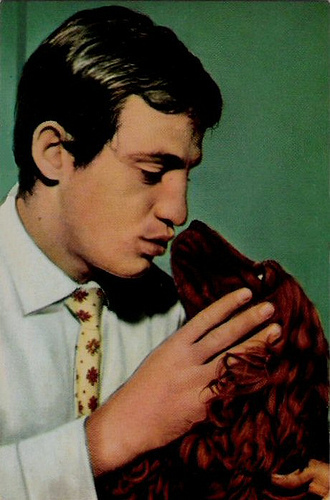
Belgian collector's card, nr. 30.
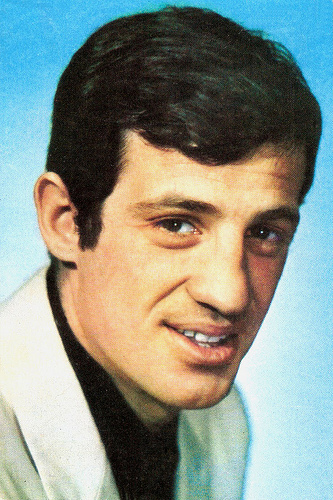
Romanian postcard by Casa Filmului Acin. Photo: Sam Lévin.
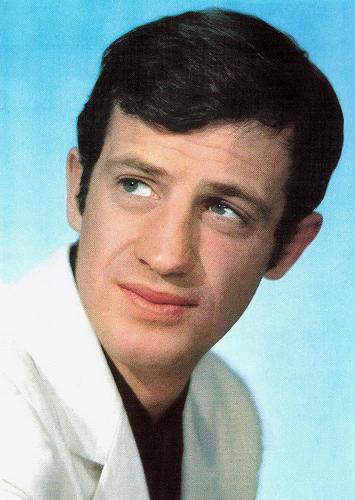
French postcard by Editions P.I., no. 1136. Photo: Sam Lévin.
Breathless
Stardom came in 1959 when Jean-Paul Belmondo took the lead role of a sympathetic gangster in Godard’s landmark feature debut A Bout de souffle/Breathless (Jean-Luc Godard, 1960). At AllMovie , Lucia Bozzola writes: "Belmondo perfectly embodied the cool youthful rebellion guiding Godard's trailblazing cinematic style, rendering Belmondo the Gallic James Dean and heir apparent to Michel Simon and Jean Gabin." This film launched not just Belmondo’s film career but also the Nouvelle Vague , the New Wave of the French cinema. Belmondo would play a major part in the Nouvelle Vague during the early 1960s with roles in e.g. Une femme est une femme/A Woman Is a Woman (Jean-Luc Godard, 1961) and Pierrot le fou/Pierrot Goes Wild (Jean-Luc Godard, 1965). Besides these classics he also acted in a stream of other excellent films: Classe tous risques/The Big Risk (Claude Sautet, 1960) with Lino Ventura, Moderato cantabile/Seven Days... Seven Nights (Peter Brook, 1960), La Ciociara/Two Women (Vittorio De Sica, 1960) with Sophia Loren, and La Viaccia/The Lovemakers (Mauro Bolognini, 1961) with Claudia Cardinale. He played a priest in the dark World War II drama Léon Morin, prêtre/Leon Morin, Priest (Jean-Pierre Melville, 1961). Very popular was the swashbuckler Cartouche (Philippe de Broca, 1962) again with Cardinale. In Un singe en hiver/A Monkey in Winter (Henri Verneuil, 1962) he appeared with Jean Gabin. All that and the two films he made with Jean-Pierre Melville, Le Doulos/The Fingerman (Jean-Pierre Melville, 1962) and L’Aîné des Ferchaux/An Honorable Young Man (1963), which became modern classics of the film noir.
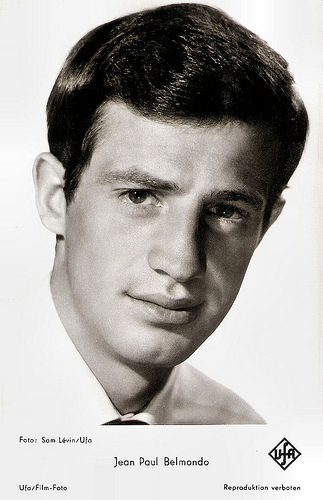
German postcard by Ufa/Film-Foto, no. 1133. Photo: Sam Lévin / Ufa.
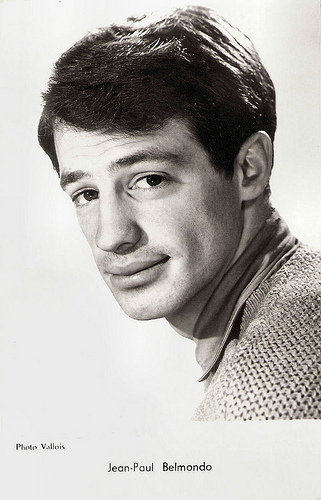
French postcard by Editions P.I., no. 1133. Photo: Vallois.
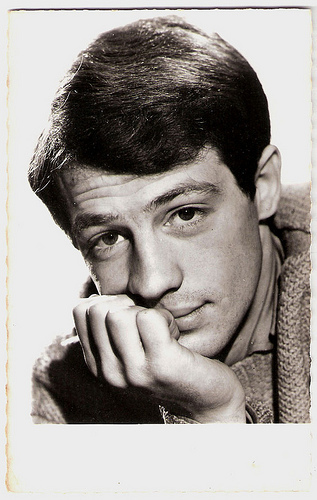
French postcard by Editions P.I., offered by Les Carbones Korès 'Carboplane', no. 1034. Photo: Studio Vallois.
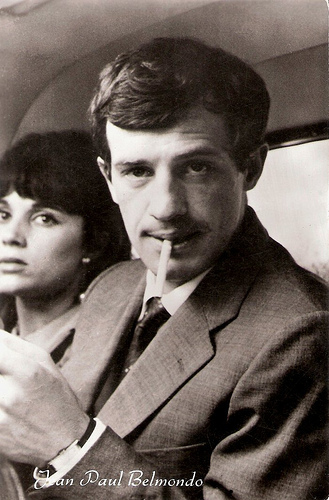
Dutch postcard by SYBA, no. 44/364.
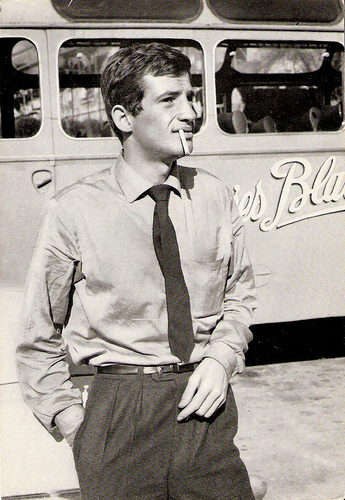
German postcard by WS-Druck, Wanne-Eickel, no. 559.
Mainstream
With L’homme de Rio/That Man from Rio (Philippe de Broca, 1964), Jean-Paul Belmondo switched to commercial, mainstream productions and became a big comedy and action star in France. During the production of their next hit comedy Les tribulations d'un Chinois en Chine/Chinese Adventures in China (Philippe de Broca, 1965), Belmondo fell in love with his co-star Ursula Andress. Following the example of Alain Delon he founded his own production company, Cerito Films, which produced around a dozen of his films over the next decade. Until the mid-1980s, his typical characters were either dashing adventurers or more cynical heroes in such films as Cent mille dollars au soleil/Greed in the Sun (Henri Verneuil, 1964) with Lino Ventura, Le Voleur/The Thief (Louis Malle, 1967), La Sirène du Mississipi/Mississippi Mermaid (Francois Truffaut, 1969) with Catherine Deneuve, Borsalino (Jacques Deray, 1970) opposite Alain Delon, and Stavisky... (Alain Resnais, 1974). Returning to his athletic roots, Belmondo became renowned for doing his own stunts as well as for his charming screen presence in such action films as the James Bond parody Le Magnifique/The Magnificent One (Philippe de Broca, 1973) with Jacqueline Bisset, L'Animal/The Beast (Claude Zidi, 1977) with Raquel Welch, and Le Professionnel/The Professional (Georges Lautner, 1981). Belmondo was one of France's biggest box-office stars of his time. He ceased to perform all the stunts himself after an accident during the filming of Hold-Up (Alexandre Arcady, 1985) with Kim Cattrall. He made a spectacular return to the theatre in 1987, appearing in Kean. Since then he has continued to perform on stage to great acclaim, whilst simultaneously pursuing his film career.
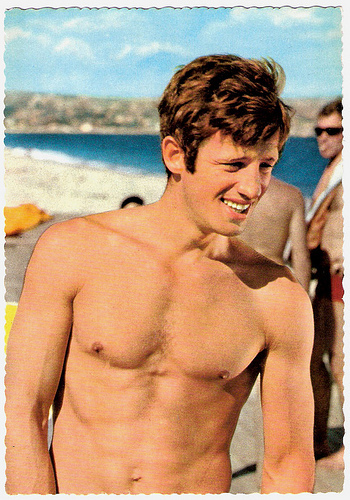
German postcard by Krüger, no. 902/345. Photo: Gérard Decaux.

Italian postcard. Photo: Dear Film. Publicity still for Les tribulations d'un Chinois en Chine/Chinese Adventures in China (Philippe de Broca, 1965).
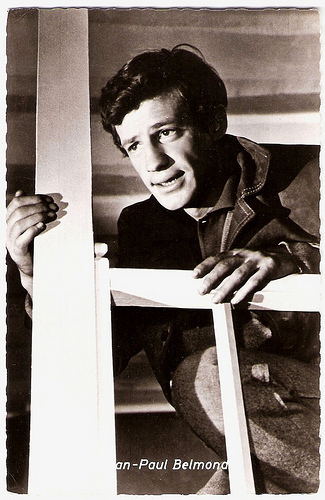
German postcard by Kolibri-Verlag G.m.b.H., Minden-Westf., no. 1334.
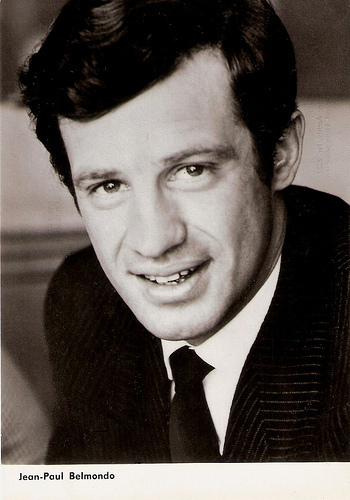
East-German postcard by VEB Progress Film-Vertrieb, Berlin, no. 2325.
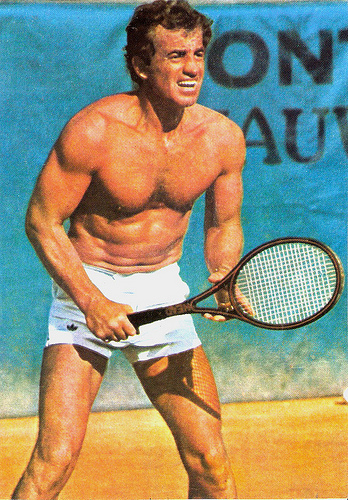
Romanian postcard by Casa Filmului Acin, lei 2.
No César
Jean-Paul Belmondo now prefers mostly dramatic roles. In 1989 he was awarded the César for his performance in Itinéraire d'un enfant gâté/The Lion (Claude Lelouch, 1988). He refused to take the trophy because César, the sculptor who designed the award and gave it his name, had once expressed bad opinions about the work of his father. Another popular dramatic film was Les Misérables (Claude Lelouch, 1995). Jean-Paul Belmondo married twice. In 1953, he married dancer Élodie Constantin, with whom he had three children: Patricia (1958), Florence (1960) and Paul (1963). Paul became a Formula One driver; his eldest daughter Patricia was killed in a fire in 1994. In 1966, due to the well-publicized affair between Belmondo and actress Ursula Andress, Belmondo and his wife divorced. Later he had a long relationship with Italian actress Laura Antonelli. In 1989, he met Nathalie Tardivel who was 24 years old at the time. Belmondo married her in 2002. In 2001, he suffered a stroke and for years he was absent from stage and screen. In 2003, at the age of 70, his fourth child Stella was born. In 2008, Belmondo and Tardivel divorced. Since 2007 he has been 'Commandeur de la Légion d'honneur' (Commander of the Legion of Honour), France’s highest accolade. Recently he returned performing in the Theatre Marigny in Paris. His most recent film production is Un homme et son chien/A Man and His Dog (Francis Huster, 2009), a remake of the classic Umberto D (Vittorio De Sica, 1952). The film was not well-received. In 2011, the Cannes Film Festival paid tribute to him by giving him a special Palme d’Or to commemorate his exceptional body of work. But Jean-Paul Belmondo is not dead yet. In production now is his new collaboration with director Claude Lelouch, Les Bandits manchots (2013) .
Scene from Bébel's film debut Les Copains du dimanche (1956-1958). Source: ROBAGGIO10 (YouTube).
Scene from Borsalino (1970) with Jean-Paul Belmondo and Alain Delon. Source: myytsent (YouTube).
Trailer of Le Magnifique (1973). Source: vivadjango (YouTube).
Sources: Lucia Bozzola (AllMovie), James Travers (Films de France), Wikipedia, Films de France, and

Spanish postcard by Oscarcolor, Barcelona, no. 83, 1964. Photo: Sam Lévin.

French postcard by E.D.U.G., no. 160. Photo: Sam Lévin.

Italian postcard in the series Artisti di sempre by Rotalfoto, Milano, no. 355.

French postcard by E.D.U.G., no. 77. Photo: Lucienne Chevert.

French postcard by Editions P.I., Paris, no. 1065, presented by Corvisart, Epinal. Photo: Sam Lévin.
Bébel
Jean-Paul Belmondo was born in Neuilly-sur-Seine, a commune in the western suburbs of Paris, in 1933. He is the son of Paul Belmondo, a sculptor of Sicilian descent. Young Jean-Paul did not perform well at school, but developed a passion for boxing before he decided that his future lay in acting. After a number of attempts, he finally gained admittance to the Paris Conservatoire in 1952, although his tutors were not overly optimistic about his prospects. It was here that he acquired the nickname 'Bébel'. In the mid-1950s, he appeared in a few theatrical productions, often to great acclaim, before beginning a film career in 1956 with Les Copains du dimanche/The Sunday Friends (Henry Aisner, 1956-1958). The film was never played in public cinemas though and his episodes in À pied, à cheval et en voiture/On Foot, on Horse, and on Wheels (Maurice Delbez, 1957) were even cut before release, but soon bigger roles followed in the spoof thriller Sois Belle et Tais-Toi/Be Beautiful But Shut Up (Marc Allégret, 1957) - his first co-starring role with Alain Delon, the hit Les Tricheurs/The Cheaters (Marcel Carné, 1958) and À double tour/Web of Passion (Claude Chabrol, 1959) with Madeleine Robinson. It was in 1958 that the 25-year-old Belmondo attracted the attention of a former critic turned filmmaker Jean-Luc Godard. The latter was impressed by the actor’s spontaneity and cast him first in a quirky short, Charlotte et son Jules (1959).

French postcard by E.D.U.G., nr. 233. Photo: Sam Lévin.

French postcard by E.D.U.G., nr. 78. Photo: Lucienne Chevert.

Belgian collector's card, nr. 30.

Romanian postcard by Casa Filmului Acin. Photo: Sam Lévin.

French postcard by Editions P.I., no. 1136. Photo: Sam Lévin.
Breathless
Stardom came in 1959 when Jean-Paul Belmondo took the lead role of a sympathetic gangster in Godard’s landmark feature debut A Bout de souffle/Breathless (Jean-Luc Godard, 1960). At AllMovie , Lucia Bozzola writes: "Belmondo perfectly embodied the cool youthful rebellion guiding Godard's trailblazing cinematic style, rendering Belmondo the Gallic James Dean and heir apparent to Michel Simon and Jean Gabin." This film launched not just Belmondo’s film career but also the Nouvelle Vague , the New Wave of the French cinema. Belmondo would play a major part in the Nouvelle Vague during the early 1960s with roles in e.g. Une femme est une femme/A Woman Is a Woman (Jean-Luc Godard, 1961) and Pierrot le fou/Pierrot Goes Wild (Jean-Luc Godard, 1965). Besides these classics he also acted in a stream of other excellent films: Classe tous risques/The Big Risk (Claude Sautet, 1960) with Lino Ventura, Moderato cantabile/Seven Days... Seven Nights (Peter Brook, 1960), La Ciociara/Two Women (Vittorio De Sica, 1960) with Sophia Loren, and La Viaccia/The Lovemakers (Mauro Bolognini, 1961) with Claudia Cardinale. He played a priest in the dark World War II drama Léon Morin, prêtre/Leon Morin, Priest (Jean-Pierre Melville, 1961). Very popular was the swashbuckler Cartouche (Philippe de Broca, 1962) again with Cardinale. In Un singe en hiver/A Monkey in Winter (Henri Verneuil, 1962) he appeared with Jean Gabin. All that and the two films he made with Jean-Pierre Melville, Le Doulos/The Fingerman (Jean-Pierre Melville, 1962) and L’Aîné des Ferchaux/An Honorable Young Man (1963), which became modern classics of the film noir.

German postcard by Ufa/Film-Foto, no. 1133. Photo: Sam Lévin / Ufa.

French postcard by Editions P.I., no. 1133. Photo: Vallois.

French postcard by Editions P.I., offered by Les Carbones Korès 'Carboplane', no. 1034. Photo: Studio Vallois.

Dutch postcard by SYBA, no. 44/364.

German postcard by WS-Druck, Wanne-Eickel, no. 559.
Mainstream
With L’homme de Rio/That Man from Rio (Philippe de Broca, 1964), Jean-Paul Belmondo switched to commercial, mainstream productions and became a big comedy and action star in France. During the production of their next hit comedy Les tribulations d'un Chinois en Chine/Chinese Adventures in China (Philippe de Broca, 1965), Belmondo fell in love with his co-star Ursula Andress. Following the example of Alain Delon he founded his own production company, Cerito Films, which produced around a dozen of his films over the next decade. Until the mid-1980s, his typical characters were either dashing adventurers or more cynical heroes in such films as Cent mille dollars au soleil/Greed in the Sun (Henri Verneuil, 1964) with Lino Ventura, Le Voleur/The Thief (Louis Malle, 1967), La Sirène du Mississipi/Mississippi Mermaid (Francois Truffaut, 1969) with Catherine Deneuve, Borsalino (Jacques Deray, 1970) opposite Alain Delon, and Stavisky... (Alain Resnais, 1974). Returning to his athletic roots, Belmondo became renowned for doing his own stunts as well as for his charming screen presence in such action films as the James Bond parody Le Magnifique/The Magnificent One (Philippe de Broca, 1973) with Jacqueline Bisset, L'Animal/The Beast (Claude Zidi, 1977) with Raquel Welch, and Le Professionnel/The Professional (Georges Lautner, 1981). Belmondo was one of France's biggest box-office stars of his time. He ceased to perform all the stunts himself after an accident during the filming of Hold-Up (Alexandre Arcady, 1985) with Kim Cattrall. He made a spectacular return to the theatre in 1987, appearing in Kean. Since then he has continued to perform on stage to great acclaim, whilst simultaneously pursuing his film career.

German postcard by Krüger, no. 902/345. Photo: Gérard Decaux.

Italian postcard. Photo: Dear Film. Publicity still for Les tribulations d'un Chinois en Chine/Chinese Adventures in China (Philippe de Broca, 1965).

German postcard by Kolibri-Verlag G.m.b.H., Minden-Westf., no. 1334.

East-German postcard by VEB Progress Film-Vertrieb, Berlin, no. 2325.

Romanian postcard by Casa Filmului Acin, lei 2.
No César
Jean-Paul Belmondo now prefers mostly dramatic roles. In 1989 he was awarded the César for his performance in Itinéraire d'un enfant gâté/The Lion (Claude Lelouch, 1988). He refused to take the trophy because César, the sculptor who designed the award and gave it his name, had once expressed bad opinions about the work of his father. Another popular dramatic film was Les Misérables (Claude Lelouch, 1995). Jean-Paul Belmondo married twice. In 1953, he married dancer Élodie Constantin, with whom he had three children: Patricia (1958), Florence (1960) and Paul (1963). Paul became a Formula One driver; his eldest daughter Patricia was killed in a fire in 1994. In 1966, due to the well-publicized affair between Belmondo and actress Ursula Andress, Belmondo and his wife divorced. Later he had a long relationship with Italian actress Laura Antonelli. In 1989, he met Nathalie Tardivel who was 24 years old at the time. Belmondo married her in 2002. In 2001, he suffered a stroke and for years he was absent from stage and screen. In 2003, at the age of 70, his fourth child Stella was born. In 2008, Belmondo and Tardivel divorced. Since 2007 he has been 'Commandeur de la Légion d'honneur' (Commander of the Legion of Honour), France’s highest accolade. Recently he returned performing in the Theatre Marigny in Paris. His most recent film production is Un homme et son chien/A Man and His Dog (Francis Huster, 2009), a remake of the classic Umberto D (Vittorio De Sica, 1952). The film was not well-received. In 2011, the Cannes Film Festival paid tribute to him by giving him a special Palme d’Or to commemorate his exceptional body of work. But Jean-Paul Belmondo is not dead yet. In production now is his new collaboration with director Claude Lelouch, Les Bandits manchots (2013) .
Scene from Bébel's film debut Les Copains du dimanche (1956-1958). Source: ROBAGGIO10 (YouTube).
Scene from Borsalino (1970) with Jean-Paul Belmondo and Alain Delon. Source: myytsent (YouTube).
Trailer of Le Magnifique (1973). Source: vivadjango (YouTube).
Sources: Lucia Bozzola (AllMovie), James Travers (Films de France), Wikipedia, Films de France, and
Published on July 07, 2013 23:00
July 6, 2013
Lotte Koch
German-Belgian actress Lotte Koch (1913) appeared in anti-British propaganda films of the Ufa, but she also starred in Morituri (1948), the first German film about concentration camps and the Holocaust. At 100, she is now with Marta Eggerth the longest living Ufa star.
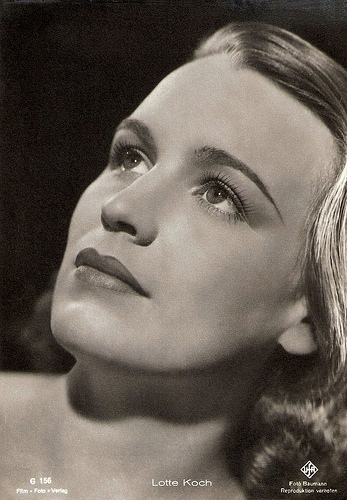
German postcard by Film-Foto-Verlag, no. G 156, 1941-1944. Photo: Baumann / Ufa.
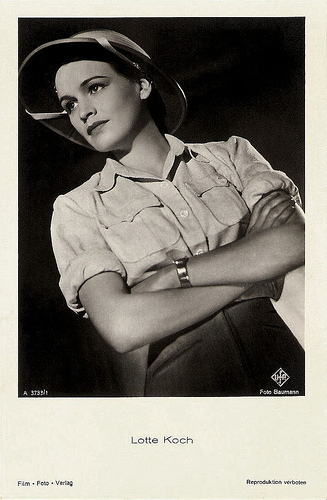
German postcard by Film-Foto-Verlag, no. A 3733/1, 1927-1928. Photo: Baumann / Ufa.
Die Pfeffermühle
Lotte Koch was born as Luise Charlotte Koch in Brussels, Belgium in 1913. After finishing school, she visited the Hochschule für Bühnenkunst (School of Performing Arts) in Dusseldorf, where she studied under Louise Dumont. She received her first theatre engagement in 1931 in Heidelberg. She was then engaged by the noted Schauspielhaus Zurich (1935-1937), where she played classical heroines as Luise in Kabale und Liebe (Intrigue and Love) by Friedrich Schiller and Helena in Jean Giraudoux's Der trojanische Krieg findet nicht statt (The Trojan war will not take place), both under the direction of Leopold Lindtberg. In Zürich, she also performed in Klaus and Erika Mann’s cabaret Die Pfeffermühle. In 1936 she made her film debut in the Johann Nepomuk Nestroy adaptation Lumpacivagabundus/Lumpaci the Vagabond (1936, Géza von Bolváry) with Paul Hörbiger and Heinz Rühmann. Then followed a pause in her film career of four years. In the meantime, she played on stage at the Volkstheater Wien (National Theatre Vienna) (1938-1939) and the Hamburger Kammerspiele (Hamburg Kammerspiele).
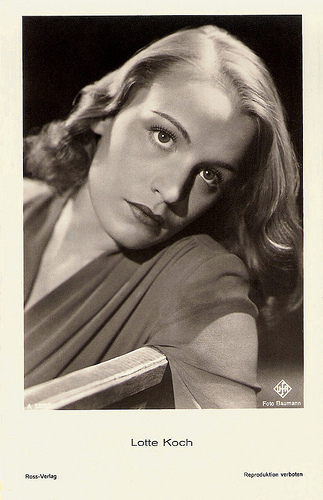
German postcard by Ross-Verlag, no. A 3325/1, 1941-1944. Photo: Baumann / Ufa.
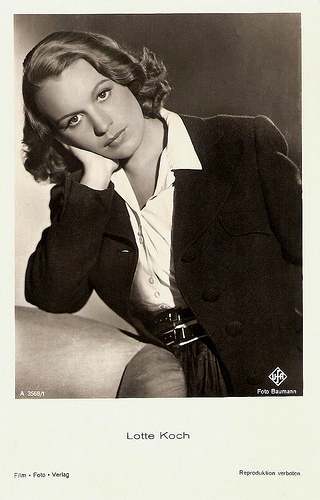
German postcard by Film-Foto-Verlag, no. A 3568/1, 1941-1944. Photo: Baumann / Ufa.
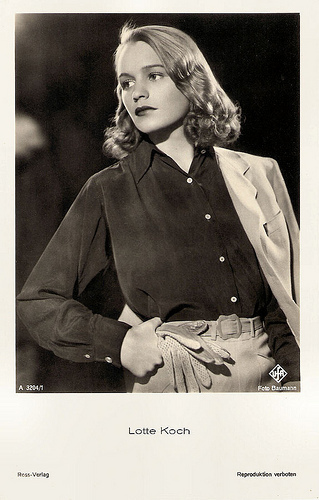
German postcard by Ross-Verlag, no. A 3204/1, 1941-1944. Photo: Baumann / Ufa.
MorituriDuring the Second World War, Lotte Koch regularly appeared in UFA productions, both in leading and supporting roles. She played in the historical melodrama, Das Herz der Königin/The Heart of the Queen (1940, Carl Froelich) starring Zarah Leander. The film made selective use of the tragic life story of Mary, Queen of Scots and her execution by Queen Elizabeth I for anti-British propaganda purposes. Her other films included the drama Friedemann Bach (1941, Traugott Müller, Gustaf Gründgens) with Gustaf Gründgens as the son of Sebastian Johann Bach, and the anti-British thriller Anschlag auf Baku/Attack on Baku (1942, Fritz Kirchhoff) starring Willy Fritsch and René Deltgen. In these films she was often cast as the assistant, a typical cliché role for women in the films of the Third Reich. After the war, Koch co-starred in the drama … und über uns der Himmel/City of Torment (1947, Josef von Báky). She played a young war widow opposite Hans Albers as a returning war veteran who has trouble finding work. A special film was Morituri (1948, Eugen York) in which she played the lead. The story was based in part on the life of producer Artur Brauner. It tells of the escape of Nazi concentration camp prisoners and how they manage to hide and evade recapture, though faced with constant danger and starvation. The film premiered at the Venice Film Festival 1948. In Germany, Morituri was a commercial disaster, with audiences hissing and booing. A theatre in Hamburg was vandalized, after which other theater owners, fearful of reprisal by Nazi sympathizers, refused to show the film. In her last film, the comedy Käpt'n Bay-Bay (1953, Helmut Käutner) she was again the partner of Hans Albers. In 1953 Lotte Koch finished her film career almost entirely. She worked for television and theatre. In 1971, she did her last screen role in the TV series Motiv Liebe/Motive Love (1971, Hermann Leitner). Lotte Koch was married to actor Ernst von Klipstein, who had been her co-star in Das Schwarze Schaf/The Black Sheep (1944, Miroslav Cikán) and three other films. Later, she married his brother, Dieter von Klipstein. She now lives in an elderly home in Unterhaching in the south of Germany. There, Lotte Koch had her 100th birthday on 9 March this year.
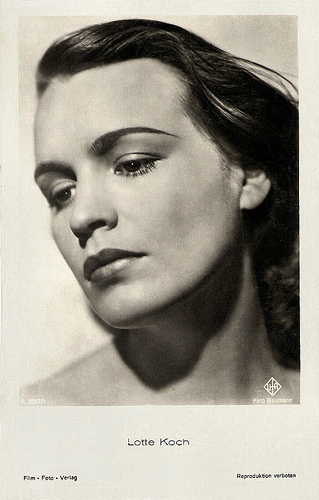
German postcard by Film-Foto-Verlag, no. A 3847/1, 1941-1944. Photo: Baumann / Ufa.
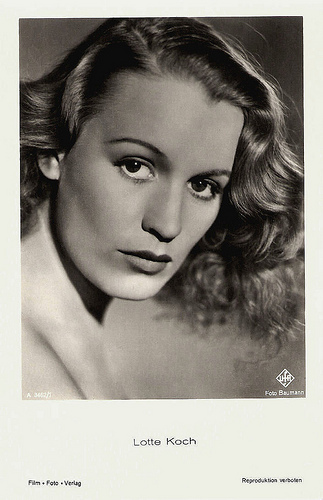
German postcard by Film-Foto-Verlag, no. A 3462/1, 1941-1944. Photo: Baumann / Ufa.
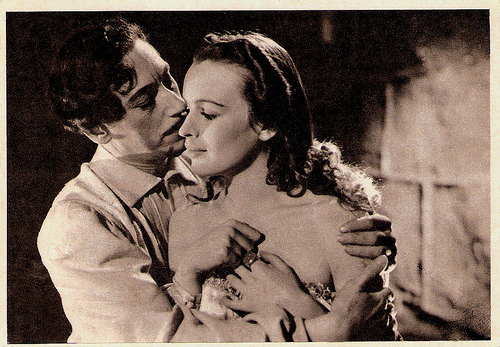
German postcard by Das Illustrierte Blatt . Photo: Ufa/Lindner. Publicity still for Das Herz der Königin/Mary Queen of Scots (1940, Carl Froelich) with Willy Birgel.
Sources: Stephanie D’heil (Steffi-Line), Thomas Staedeli (Cyranos), Hanns-Georg Rodek (Die Welt- German), AllMovie, Wikipedia (German) and

German postcard by Film-Foto-Verlag, no. G 156, 1941-1944. Photo: Baumann / Ufa.

German postcard by Film-Foto-Verlag, no. A 3733/1, 1927-1928. Photo: Baumann / Ufa.
Die Pfeffermühle
Lotte Koch was born as Luise Charlotte Koch in Brussels, Belgium in 1913. After finishing school, she visited the Hochschule für Bühnenkunst (School of Performing Arts) in Dusseldorf, where she studied under Louise Dumont. She received her first theatre engagement in 1931 in Heidelberg. She was then engaged by the noted Schauspielhaus Zurich (1935-1937), where she played classical heroines as Luise in Kabale und Liebe (Intrigue and Love) by Friedrich Schiller and Helena in Jean Giraudoux's Der trojanische Krieg findet nicht statt (The Trojan war will not take place), both under the direction of Leopold Lindtberg. In Zürich, she also performed in Klaus and Erika Mann’s cabaret Die Pfeffermühle. In 1936 she made her film debut in the Johann Nepomuk Nestroy adaptation Lumpacivagabundus/Lumpaci the Vagabond (1936, Géza von Bolváry) with Paul Hörbiger and Heinz Rühmann. Then followed a pause in her film career of four years. In the meantime, she played on stage at the Volkstheater Wien (National Theatre Vienna) (1938-1939) and the Hamburger Kammerspiele (Hamburg Kammerspiele).

German postcard by Ross-Verlag, no. A 3325/1, 1941-1944. Photo: Baumann / Ufa.

German postcard by Film-Foto-Verlag, no. A 3568/1, 1941-1944. Photo: Baumann / Ufa.

German postcard by Ross-Verlag, no. A 3204/1, 1941-1944. Photo: Baumann / Ufa.
MorituriDuring the Second World War, Lotte Koch regularly appeared in UFA productions, both in leading and supporting roles. She played in the historical melodrama, Das Herz der Königin/The Heart of the Queen (1940, Carl Froelich) starring Zarah Leander. The film made selective use of the tragic life story of Mary, Queen of Scots and her execution by Queen Elizabeth I for anti-British propaganda purposes. Her other films included the drama Friedemann Bach (1941, Traugott Müller, Gustaf Gründgens) with Gustaf Gründgens as the son of Sebastian Johann Bach, and the anti-British thriller Anschlag auf Baku/Attack on Baku (1942, Fritz Kirchhoff) starring Willy Fritsch and René Deltgen. In these films she was often cast as the assistant, a typical cliché role for women in the films of the Third Reich. After the war, Koch co-starred in the drama … und über uns der Himmel/City of Torment (1947, Josef von Báky). She played a young war widow opposite Hans Albers as a returning war veteran who has trouble finding work. A special film was Morituri (1948, Eugen York) in which she played the lead. The story was based in part on the life of producer Artur Brauner. It tells of the escape of Nazi concentration camp prisoners and how they manage to hide and evade recapture, though faced with constant danger and starvation. The film premiered at the Venice Film Festival 1948. In Germany, Morituri was a commercial disaster, with audiences hissing and booing. A theatre in Hamburg was vandalized, after which other theater owners, fearful of reprisal by Nazi sympathizers, refused to show the film. In her last film, the comedy Käpt'n Bay-Bay (1953, Helmut Käutner) she was again the partner of Hans Albers. In 1953 Lotte Koch finished her film career almost entirely. She worked for television and theatre. In 1971, she did her last screen role in the TV series Motiv Liebe/Motive Love (1971, Hermann Leitner). Lotte Koch was married to actor Ernst von Klipstein, who had been her co-star in Das Schwarze Schaf/The Black Sheep (1944, Miroslav Cikán) and three other films. Later, she married his brother, Dieter von Klipstein. She now lives in an elderly home in Unterhaching in the south of Germany. There, Lotte Koch had her 100th birthday on 9 March this year.

German postcard by Film-Foto-Verlag, no. A 3847/1, 1941-1944. Photo: Baumann / Ufa.

German postcard by Film-Foto-Verlag, no. A 3462/1, 1941-1944. Photo: Baumann / Ufa.

German postcard by Das Illustrierte Blatt . Photo: Ufa/Lindner. Publicity still for Das Herz der Königin/Mary Queen of Scots (1940, Carl Froelich) with Willy Birgel.
Sources: Stephanie D’heil (Steffi-Line), Thomas Staedeli (Cyranos), Hanns-Georg Rodek (Die Welt- German), AllMovie, Wikipedia (German) and
Published on July 06, 2013 23:00
July 5, 2013
Vittorio De Sica
Today it's the eighth and final day of
Il Cinema Ritrovato 2013
in Bologna, Italy. Our last festival post is about Vittorio De Sica (1901-1974). Bologna presents a retrospective about the Italian maestro: Tenderly Ironic: Vittorio De Sica, Actor and Director. Citing the festival newsletter: "A Maestro, a father, a beacon of Italian cinema. Vittorio De Sica is Italy's first modern superstar and a pivotal figure in our country's collective memory."
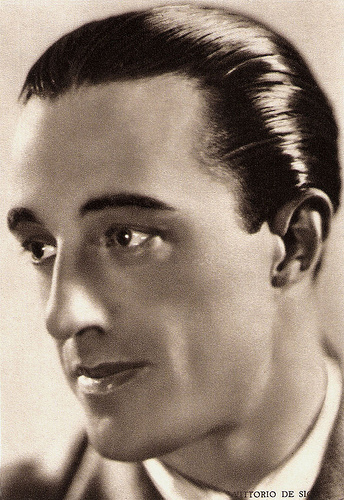
Italian postcard by Rizzoli S.C., Milano, 1936.
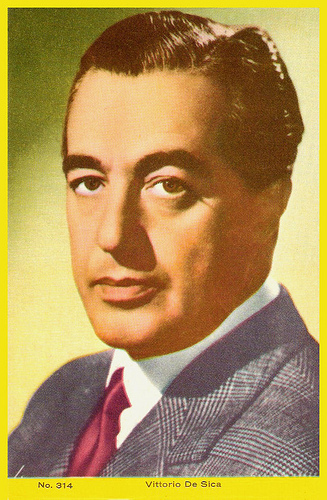
Mexican card, no. 314.
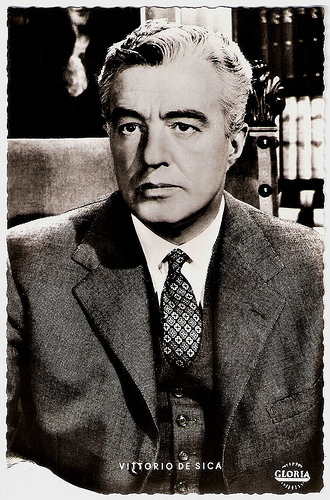
German postcard by Kunst und Bild, Berlin, no. V 377. Photo: Gloria Film. Publicity still for Racconti Romani/Roman Tales (Gianni Franciolini, 1955).
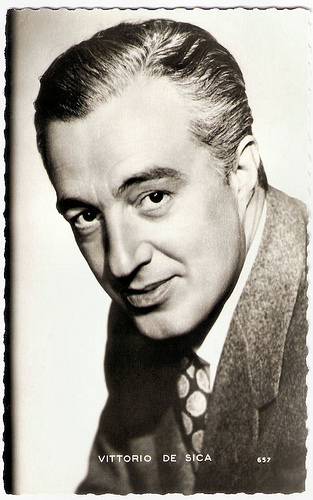
French postcard by Editions P.I., no. 37 G, presented by Les Carbones Korès Carboplane. Photo: Sam Lévin.
Successful Matinee Idol
Vittorio Domenico Stanislao Gaetano Sorano De Sica was born in Sora, Italy in 1901 (or 1902 - sources are divided). He grew up in Naples. His father, Umberto De Sica, a bank clerk with a penchant for show business, encouraged his good-looking son to pursue a stage career. Vittorio made his screen debut at 16 in the film Il processo Clémenceau/The Clemenceau Affair (Alfredo De Antoni, 1917) starring the legendary diva Francesca Bertini. He began his career as a theatre actor in the early 1920s and joined Tatiana Pavlova's theatre company in 1923. By the late 1920s he was a successful matinee idol of the Italian stage, and also appeared in such silent films as La bellezza del mondo/Beauty of the World (Mario Almirante, 1927) starring another silent film diva, Italia Almirante-Manzini. In 1933 De Sica founded his own theatre company with his wife, actress Giuditta Rissone, and Sergio Tofano. The company performed mostly light comedies. His good looks and breezy manner made him an overnight matinee idol of the Italian cinema with the release of his first sound picture, La Vecchia Signora/The Old Lady (Amleto Palermi, 1932). Light comedies as Gli uomini che mascalzoni!/What Scoundrels Men Are! (Mario Camerini, 1932) and Il signor Max/Mister Max (Mario Camerini, 1937) made him immensely popular with female audiences. During the Second World War De Sica turned to directing with Rose Scarlatte/Red Roses (Vittorio De Sica, Giuseppe Amato, 1940), and Maddelena, Zero in Condotta/Maddelena, Zero For Conduct (Vittorio De Sica, 1940). Both films were attempts to bring theatre pieces to the screen with suitable roles for himself. In the comedy of errors Teresa Venerdi (Vittorio De Sica, 1941) his girlfriend was played by a young Anna Magnani.
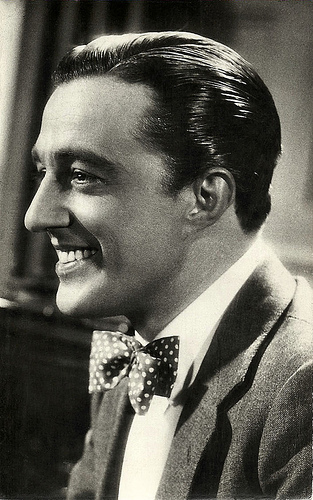
Spanish postcard by Editorial Brujuero, Barcelona, no. 481. Photo: Infonal, Archivo Bermeja.
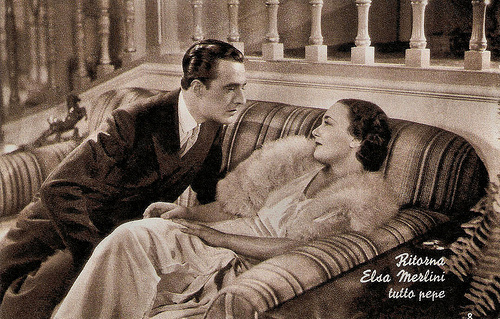
Italian postcard. The caption reads: Elsa Merlini returns, all pepper. Probably for the film Non ti conosco più/I Don't Know You Anymore (Nunzio Malasomma, Mario Bonnard, 1936). The pepper refers to the title of her previous film Paprika (Carl Boese, 1933).
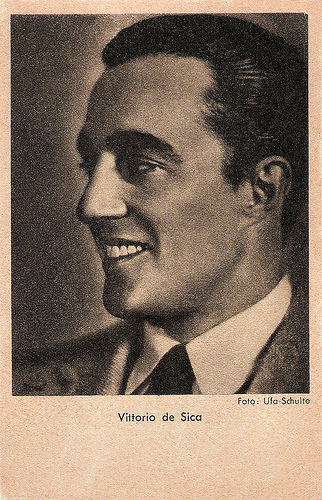
German postcard by Das Programm von Heute, Berlin. Photo: Ufa / Schulte.
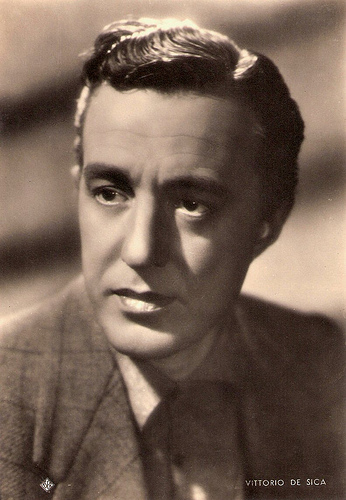
Italian postcard by Aser, Roma (Rome), no. 333. Photo: Vaselli.
Real Locations and Non-professional Actors
A turning point in Vittorio De Sica’s career was his meeting with the writer Cesare Zavattini. They worked together on De Sica’s fifth film, I bambini ci guardano/The Children Are Watching Us (Vittorio De Sica, 1943). In this film, the director began to use non-professional actors and socially conscious subject matter. He revealed hitherto unsuspected depths and an extraordinarily sensitive touch with actors, especially with children. It is a mature, perceptive, and deeply human work about the impact of adult folly on a child's innocent mind. Zavattini became as a scenarist his major collaborator for the next three decades. Together they created two of the most significant films of the Italian neorealism movement: Sciuscià/Shoeshine (Vittorio de Sica, 1946) and Ladri di biciclette/Bicycle Thieves (Vittorio de Sica, 1948). Sciuscià/Shoeshine is the story of how the lasting friendship of two homeless boys, who make their living shining shoes for the American G.I.'s, is betrayed by their contact with adults. At the end of the film one boy inadvertently causes the other's death. In Ladri di biciclette/Bicycle Thieves, workman Ricci's desperate search for his bicycle is an odyssey that enables us to witness a varied collection of characters and situations among the poor and working class of Rome. At Sony Pictures Classics an anonymous critic writes: “With no money available to produce his films, De Sica initiated the use of real locations and non-professional actors. Using available light and documentary effects, he explored the relationship between working and lower-class characters in an indifferent, and often hostile social and political environment. The result was gritty and searing storytelling that not only bared the truth about the harsh conditions inflicted on Italy's poor, but also represented a radical break from filmmaking conventions.” Both films are heartbreaking studies of poverty in postwar Italy and both won special Oscars before the foreign film category was officially established. De Sica's next collaboration with Zavattini was the satirical fantasy, Miracolo a Milano/Miracle in Milan (Vittorio de Sica, 1951), which wavered between optimism and despair in its allegorical treatment of the plight of the poor in an industrial society. Their next film, Umberto D. (Vittorio de Sica, 1952), was a relentlessly bleak study of the problems of old age and loneliness, but it was a box-office disaster. Continually wooed by Hollywood, De Sica finally acquiesced to make Stazioni Termini (Vittorio de Sica, 1952), clumsily renamed Indiscretion of an American Wife in the US It was produced by David O. Selznick and filmed in Rome with in the leading roles Selznick's wife, Jennifer Jones and Montgomery Clift. Unfortunately, neorealist representation formed only an insignificant background to this typically American star vehicle.
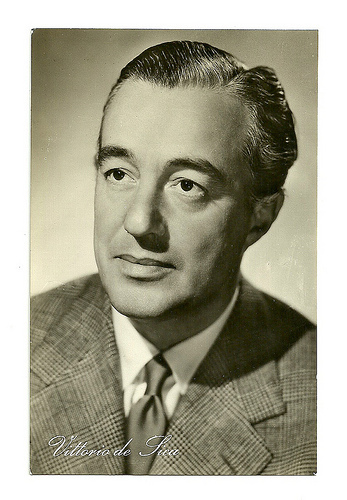
East-German postcard by Progress-Filmvertrieb.
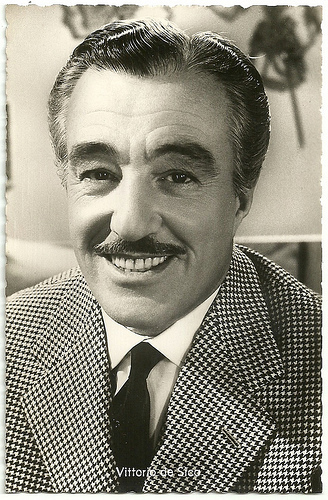
German postcard by Kolibri-Verlag, Minden. Photo: Bavaria Filmkunst-Eichberg-Marszalos. Publicity still for the Franco-Italian-German film Casino de Paris (André Hunebelle, 1957).
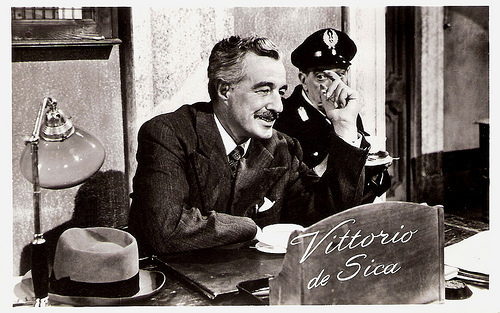
Dutch postcard by Takken, no. 1679.
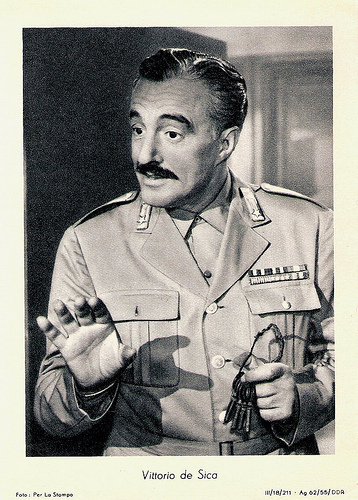
East-German postcard, no. III/18/211, 1955. Photo: Per la Stampa. De Sica wears the uniform of the marshall from the film Pane, amore e fantasia (and its sequels).
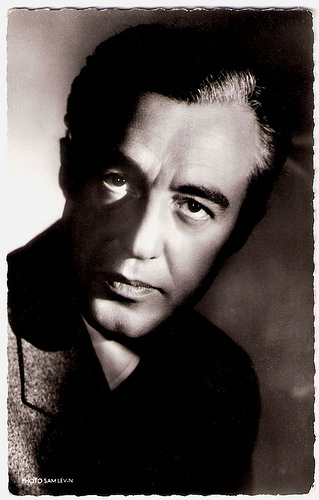
French postcard by Editions du Globe, Paris, no. 610. Photo: Sam Lévin.
Bread Love and Dreams
During his lifetime, Vittorio De Sica acted in over one hundred films in Italy and abroad, in order to finance his own directorial projects. He turned almost exclusively to acting in the late 1950s, enjoying great popularity in the role of the rural police officer Carotenuto in Pane, amore e fantasia/Bread, Love and Dreams (Luigi Comencini, 1954) opposite Gina Lollobrigida. He returned in a subsequent comedy series of the same name co-starring Lollobrigida or Sophia Loren. He was at his best playing breezy comic heroes, men of great self-assurance or confidence - such as in Rossellini's General Della Rovere (Roberto Rossellini, 1959). On TV he became well known in the British Series The Four Just Men (1959) produced by Sapphire Films. With the notable exception of Il Tetto/The Roof (Vittorio de Sica, 1956) and La Ciociara/Two Women (Vittorio de Sica, 1960), for which Sophia Loren won an Oscar for Best Actress, his subsequent output as a director was for a long while markedly less inspired and significant. He had two box-office hits with Matrimonio All'Italiana/Marriage Italian Style (Vittorio de Sica, 1964) starring Loren and Marcello Mastroianni, and with Ieri, oggi, domain/Yesterday, Today and Tomorrow (Vittorio de Sica, 1964) which won him another Oscar. However, critics and audiences alike had concluded that the aging director had lost his touch, but, just before he died he made a dramatic comeback with Il giardino dei Finzi Contini/The Garden of the Finzi-Continis (Vittorio de Sica, 1970). The film was based on a Bassani novel about the incarceration of Italian Jews during the war. According to Joel Kanoff at Film Reference it shows “a strong Viscontian influence in its lavish setting and thematics (the film deals with the dissolution of the bourgeois family).” It won him yet another Oscar. The director's next film was Una breve vacanza/A Brief Vacation (Vittorio de Sica, 1973), about a working-class Italian woman's first taste of freedom in a society dominated by males. His last film, Il Viaggio/The Voyage (Vittorio de Sica, 1974), was based on a novella by Luigi Pirandello. That year, he passed away following the removal of a cyst from his lungs. He had been married to Giuditta Rissone (1937-1968) and to Spanish actress María Mercader (1968-1974) with whom he had two sons, composer-director Manuel De Sica and actor-singer Christian De Sica. De Sica lived with Mercader from 1942 on, but couldn't marry her until 1968 after acquiring French citizenship, which allowed him to finally divorce Rissone. In 1974, Vittorio De Sica died near Paris in Neuilly-sur-Seine, at the age of 72. Active to the end, he appeared as himself in Scola's melancholic comedy-drama C'eravamo tanto amati/We All Loved Each Other So Much (Ettore Scola, 1974), which was released after his death.
A young Vittorio De Sica sings Parlami d'amore Mariu' in Gli uomini che mascalzoni!/What Scoundrels Men Are! (1932). Source: Matteoeoeo (YouTube).
Scene from Miracolo a Milano/Miracle in Milan (1953). Source: Arcilsota (YouTube).
Sophia Loren and Vittorio De Sica dance the mambo in Pane, amore e.../Bread, Love and ... (1955). Source: Il Romanziere (YouTube).
Sources: Joel Kanoff (Film Reference), Dan Harper (Senses of Cinema),

Italian postcard by Rizzoli S.C., Milano, 1936.

Mexican card, no. 314.

German postcard by Kunst und Bild, Berlin, no. V 377. Photo: Gloria Film. Publicity still for Racconti Romani/Roman Tales (Gianni Franciolini, 1955).

French postcard by Editions P.I., no. 37 G, presented by Les Carbones Korès Carboplane. Photo: Sam Lévin.
Successful Matinee Idol
Vittorio Domenico Stanislao Gaetano Sorano De Sica was born in Sora, Italy in 1901 (or 1902 - sources are divided). He grew up in Naples. His father, Umberto De Sica, a bank clerk with a penchant for show business, encouraged his good-looking son to pursue a stage career. Vittorio made his screen debut at 16 in the film Il processo Clémenceau/The Clemenceau Affair (Alfredo De Antoni, 1917) starring the legendary diva Francesca Bertini. He began his career as a theatre actor in the early 1920s and joined Tatiana Pavlova's theatre company in 1923. By the late 1920s he was a successful matinee idol of the Italian stage, and also appeared in such silent films as La bellezza del mondo/Beauty of the World (Mario Almirante, 1927) starring another silent film diva, Italia Almirante-Manzini. In 1933 De Sica founded his own theatre company with his wife, actress Giuditta Rissone, and Sergio Tofano. The company performed mostly light comedies. His good looks and breezy manner made him an overnight matinee idol of the Italian cinema with the release of his first sound picture, La Vecchia Signora/The Old Lady (Amleto Palermi, 1932). Light comedies as Gli uomini che mascalzoni!/What Scoundrels Men Are! (Mario Camerini, 1932) and Il signor Max/Mister Max (Mario Camerini, 1937) made him immensely popular with female audiences. During the Second World War De Sica turned to directing with Rose Scarlatte/Red Roses (Vittorio De Sica, Giuseppe Amato, 1940), and Maddelena, Zero in Condotta/Maddelena, Zero For Conduct (Vittorio De Sica, 1940). Both films were attempts to bring theatre pieces to the screen with suitable roles for himself. In the comedy of errors Teresa Venerdi (Vittorio De Sica, 1941) his girlfriend was played by a young Anna Magnani.

Spanish postcard by Editorial Brujuero, Barcelona, no. 481. Photo: Infonal, Archivo Bermeja.

Italian postcard. The caption reads: Elsa Merlini returns, all pepper. Probably for the film Non ti conosco più/I Don't Know You Anymore (Nunzio Malasomma, Mario Bonnard, 1936). The pepper refers to the title of her previous film Paprika (Carl Boese, 1933).

German postcard by Das Programm von Heute, Berlin. Photo: Ufa / Schulte.

Italian postcard by Aser, Roma (Rome), no. 333. Photo: Vaselli.
Real Locations and Non-professional Actors
A turning point in Vittorio De Sica’s career was his meeting with the writer Cesare Zavattini. They worked together on De Sica’s fifth film, I bambini ci guardano/The Children Are Watching Us (Vittorio De Sica, 1943). In this film, the director began to use non-professional actors and socially conscious subject matter. He revealed hitherto unsuspected depths and an extraordinarily sensitive touch with actors, especially with children. It is a mature, perceptive, and deeply human work about the impact of adult folly on a child's innocent mind. Zavattini became as a scenarist his major collaborator for the next three decades. Together they created two of the most significant films of the Italian neorealism movement: Sciuscià/Shoeshine (Vittorio de Sica, 1946) and Ladri di biciclette/Bicycle Thieves (Vittorio de Sica, 1948). Sciuscià/Shoeshine is the story of how the lasting friendship of two homeless boys, who make their living shining shoes for the American G.I.'s, is betrayed by their contact with adults. At the end of the film one boy inadvertently causes the other's death. In Ladri di biciclette/Bicycle Thieves, workman Ricci's desperate search for his bicycle is an odyssey that enables us to witness a varied collection of characters and situations among the poor and working class of Rome. At Sony Pictures Classics an anonymous critic writes: “With no money available to produce his films, De Sica initiated the use of real locations and non-professional actors. Using available light and documentary effects, he explored the relationship between working and lower-class characters in an indifferent, and often hostile social and political environment. The result was gritty and searing storytelling that not only bared the truth about the harsh conditions inflicted on Italy's poor, but also represented a radical break from filmmaking conventions.” Both films are heartbreaking studies of poverty in postwar Italy and both won special Oscars before the foreign film category was officially established. De Sica's next collaboration with Zavattini was the satirical fantasy, Miracolo a Milano/Miracle in Milan (Vittorio de Sica, 1951), which wavered between optimism and despair in its allegorical treatment of the plight of the poor in an industrial society. Their next film, Umberto D. (Vittorio de Sica, 1952), was a relentlessly bleak study of the problems of old age and loneliness, but it was a box-office disaster. Continually wooed by Hollywood, De Sica finally acquiesced to make Stazioni Termini (Vittorio de Sica, 1952), clumsily renamed Indiscretion of an American Wife in the US It was produced by David O. Selznick and filmed in Rome with in the leading roles Selznick's wife, Jennifer Jones and Montgomery Clift. Unfortunately, neorealist representation formed only an insignificant background to this typically American star vehicle.

East-German postcard by Progress-Filmvertrieb.

German postcard by Kolibri-Verlag, Minden. Photo: Bavaria Filmkunst-Eichberg-Marszalos. Publicity still for the Franco-Italian-German film Casino de Paris (André Hunebelle, 1957).

Dutch postcard by Takken, no. 1679.

East-German postcard, no. III/18/211, 1955. Photo: Per la Stampa. De Sica wears the uniform of the marshall from the film Pane, amore e fantasia (and its sequels).

French postcard by Editions du Globe, Paris, no. 610. Photo: Sam Lévin.
Bread Love and Dreams
During his lifetime, Vittorio De Sica acted in over one hundred films in Italy and abroad, in order to finance his own directorial projects. He turned almost exclusively to acting in the late 1950s, enjoying great popularity in the role of the rural police officer Carotenuto in Pane, amore e fantasia/Bread, Love and Dreams (Luigi Comencini, 1954) opposite Gina Lollobrigida. He returned in a subsequent comedy series of the same name co-starring Lollobrigida or Sophia Loren. He was at his best playing breezy comic heroes, men of great self-assurance or confidence - such as in Rossellini's General Della Rovere (Roberto Rossellini, 1959). On TV he became well known in the British Series The Four Just Men (1959) produced by Sapphire Films. With the notable exception of Il Tetto/The Roof (Vittorio de Sica, 1956) and La Ciociara/Two Women (Vittorio de Sica, 1960), for which Sophia Loren won an Oscar for Best Actress, his subsequent output as a director was for a long while markedly less inspired and significant. He had two box-office hits with Matrimonio All'Italiana/Marriage Italian Style (Vittorio de Sica, 1964) starring Loren and Marcello Mastroianni, and with Ieri, oggi, domain/Yesterday, Today and Tomorrow (Vittorio de Sica, 1964) which won him another Oscar. However, critics and audiences alike had concluded that the aging director had lost his touch, but, just before he died he made a dramatic comeback with Il giardino dei Finzi Contini/The Garden of the Finzi-Continis (Vittorio de Sica, 1970). The film was based on a Bassani novel about the incarceration of Italian Jews during the war. According to Joel Kanoff at Film Reference it shows “a strong Viscontian influence in its lavish setting and thematics (the film deals with the dissolution of the bourgeois family).” It won him yet another Oscar. The director's next film was Una breve vacanza/A Brief Vacation (Vittorio de Sica, 1973), about a working-class Italian woman's first taste of freedom in a society dominated by males. His last film, Il Viaggio/The Voyage (Vittorio de Sica, 1974), was based on a novella by Luigi Pirandello. That year, he passed away following the removal of a cyst from his lungs. He had been married to Giuditta Rissone (1937-1968) and to Spanish actress María Mercader (1968-1974) with whom he had two sons, composer-director Manuel De Sica and actor-singer Christian De Sica. De Sica lived with Mercader from 1942 on, but couldn't marry her until 1968 after acquiring French citizenship, which allowed him to finally divorce Rissone. In 1974, Vittorio De Sica died near Paris in Neuilly-sur-Seine, at the age of 72. Active to the end, he appeared as himself in Scola's melancholic comedy-drama C'eravamo tanto amati/We All Loved Each Other So Much (Ettore Scola, 1974), which was released after his death.
A young Vittorio De Sica sings Parlami d'amore Mariu' in Gli uomini che mascalzoni!/What Scoundrels Men Are! (1932). Source: Matteoeoeo (YouTube).
Scene from Miracolo a Milano/Miracle in Milan (1953). Source: Arcilsota (YouTube).
Sophia Loren and Vittorio De Sica dance the mambo in Pane, amore e.../Bread, Love and ... (1955). Source: Il Romanziere (YouTube).
Sources: Joel Kanoff (Film Reference), Dan Harper (Senses of Cinema),
Published on July 05, 2013 23:00
July 4, 2013
Elvire Popesco
This year, one of the major sections of
Il Cinema Ritrovato
(29 June - 6 July 2013) is War is near: 1938-1939. The festival organisation did not make the most obvious choices for the section, but selected "films which captivate fear and frail hopes, random shadows, inconclusive dialogues, everything that the greatest films around that period, such as Renoir's La Règle du jeu, did so miraculously". One of these films is Paradis perdu/Paradise Lost (1939), directed by Abel Gance and starring Elvire Popesco (1894-1993), a French actress of Romanian origin. In the twenties she went to Paris, where she conquered the stages with her comic talent and heavy accent. In the thirties she became a popular film star, who worked with such great directors as Julien Duvivier, Sacha Guitry, Marc Allégret, and of course Abel Gance.
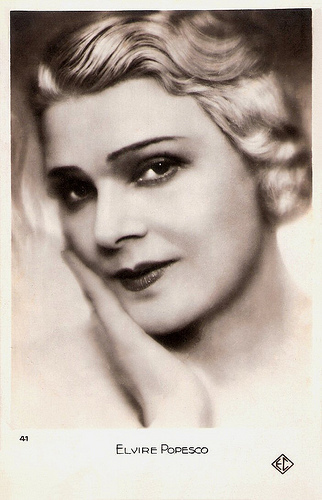
French postcard by EC, no. 41.
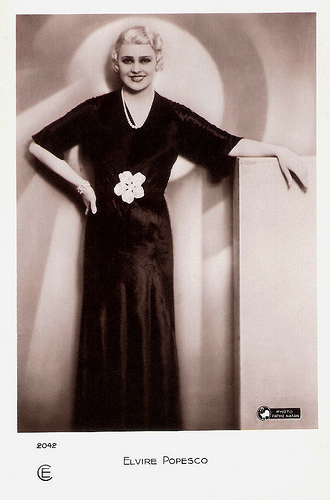
French postcard by CE (Cinemagazine-Selection), Paris, no. 2042. Photo: Pathé Natan.
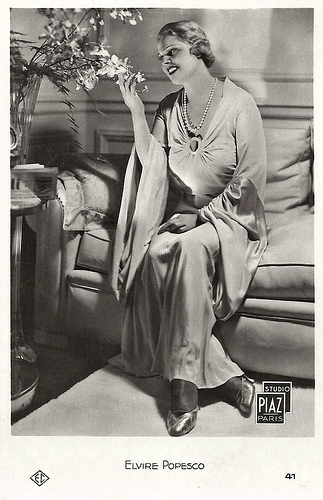
French postcard by EC, no. 41. Photo: Studio Piaz, Paris.
Artistic Director
Elvire Popesco was born Elvira Popescu in Bucharest, Romania in 1894. She started to perform at the Teatrul Naţional (Bucharest national theatre) after a training at the Conservatorul de Artă Dramatică din Bucureşti (Bucharest Conservatory for Drama). She played a small part in the Romanian silent film Independenta Romaniei/The War for Independence (Aristide Demetriade, 1912), inspired by the war between Romania and the Ottoman Empire. It was the first Romanian feature film to last for nearly two hours (from which are about 20 minutes lost now). Seven years later Elvira became the artistic director of the Excelsior Theatre (1919) and subsequently of the Teatrul Mic (1921). Then she played in the film Tigancusa de la iatac/The girl of the garret (Alfred Halm, 1923). French playwright Louis Verneuil convinced her to go to Paris. Around 1924 she rose to stardom at the Parisian stages because of her comic talent and her heavy accent. She was Verneuil's favourite actress in the later 1920s and early 1930s. He first cast her in Ma cousine de Varsovie (1923). In 1931 she would also play in the film version of this play, directed by the Italian director Carmine Gallone. Actually, from the start of sound cinema in France, Popesco had a growing prolific career there, culminating in nine film parts in 1938-1939. She worked with a wide range of directors, a.o. four times with Pierre Colombier (including Tricoche et Cacolet/Tricoche and Cacolet, 1938), but also with Julien Duvivier (L'Homme du jour/The Man of the Hour, 1936), Abel Gance (Paradis perdu/Paradise Lost, 1939), Sacha Guitry (Ils étaient neuf célibataires/Nine Bachelors, 1939), and Marc Allégret (Parade en sept nuits/Parade in 7 Nights, 1940). Her co-stars in those years were men like Maurice Chevalier, Louis Jouvet, Erich von Stroheim, Fernandel, and Henri Garat.
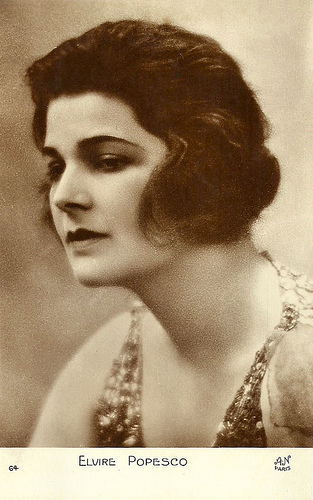
French postcard by A.N., Paris, no. 64.
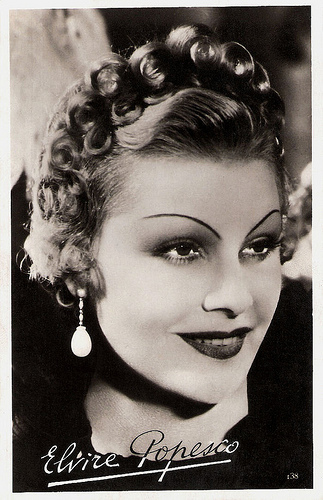
French postcard by Editions et Publications Cinématographiques, no. 138.
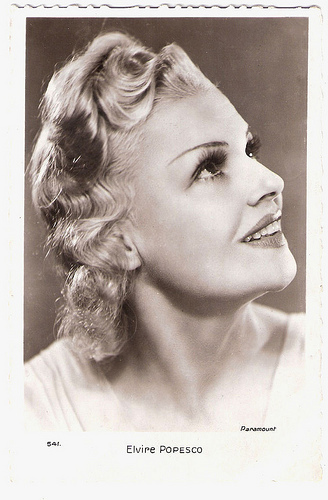
French postcard by Ed. Chantal, Paris, no. 541. Photo: Paramount.
A Big Stage Come-back
In the first war years Elvire Popesco continued to play in films like Mademoiselle Swing (Richard Pottier, 1941) with Jean Murat and Irène de Trebert. Presumably this affected her career because only in 1948 she could make a big stage come-back with Tovaritch by Jacques Deval, which was retaken with Popesco in 1960. After that Popesco had again an active stage career, playing for instance in three pieces by André Roussin: Nina (1949), La voyante (1963-1964), and La Mamma (1957-1958, 1974); the latter was purposefully written for her by Roussin. She also performed in La machine infernale by Jean Cocteau (1953). From 1953 to 1965 she was director of the Théàtre de Paris and subsequently of the Théàtre de Marigny (1965-1978). In 1959 Popesco returned to the cinema and played her last film parts in Plein soleil/Purple Noon (René Clement, 1960) starring Alain Delon, and as Napoleon's mother in Austerlitz/The Battle of Austerlitz (Abel Gance, 1960). After she had married the count Maximilien Sebastien Foy (her third husband), Popesco kept a well-frequented salon in Mézy-sur-Seine (Yvelines). From 1930 to 1985 she lived there in a modernist-style villa, owned before by fashion designer Paul Poiret, and remodelled in 1932 by architect Paul Boyer. Together with Anna de Noailles, Marthe Bibesco and Elena Vacarescu, Popesco seems to have been Henri Matisse's inspiration for his La blouse roumaine (1940). In 1987 Popesco was awarded a Molière d’honneur for her entire career, and in 1989 president François Mitterrand made her a Commandeur de la Légion d'honneur. Elvire Popesco died in 1993 in Paris at the age of 99. She lies buried at the Cimetière du Père-Lachaise in Paris. She was married to comedian Aurel Athanasescu with whom she had a daughter, Tatiana; to politician Ion Manolescu-Stronga (Minister of Industry and Commerce), and to count Maximilien Sebastien Foy.
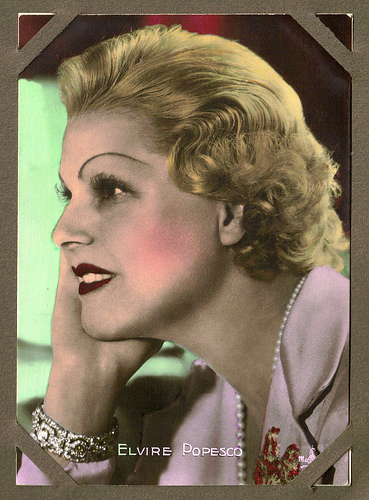
French card by Massilia. Collection: Amit Benyovits.
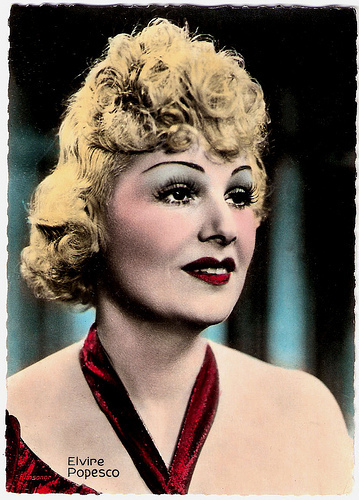
French postcard. Photo: Filmsonor.
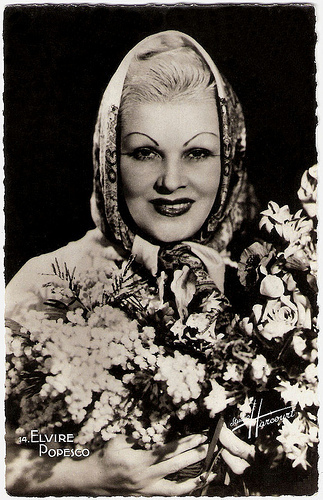
French postcard by S.E.R.P., no. 14. Photo: Studio Harcourt.
Sources: Caroline Hanotte (CinéArtistes), Wikipedia, and

French postcard by EC, no. 41.

French postcard by CE (Cinemagazine-Selection), Paris, no. 2042. Photo: Pathé Natan.

French postcard by EC, no. 41. Photo: Studio Piaz, Paris.
Artistic Director
Elvire Popesco was born Elvira Popescu in Bucharest, Romania in 1894. She started to perform at the Teatrul Naţional (Bucharest national theatre) after a training at the Conservatorul de Artă Dramatică din Bucureşti (Bucharest Conservatory for Drama). She played a small part in the Romanian silent film Independenta Romaniei/The War for Independence (Aristide Demetriade, 1912), inspired by the war between Romania and the Ottoman Empire. It was the first Romanian feature film to last for nearly two hours (from which are about 20 minutes lost now). Seven years later Elvira became the artistic director of the Excelsior Theatre (1919) and subsequently of the Teatrul Mic (1921). Then she played in the film Tigancusa de la iatac/The girl of the garret (Alfred Halm, 1923). French playwright Louis Verneuil convinced her to go to Paris. Around 1924 she rose to stardom at the Parisian stages because of her comic talent and her heavy accent. She was Verneuil's favourite actress in the later 1920s and early 1930s. He first cast her in Ma cousine de Varsovie (1923). In 1931 she would also play in the film version of this play, directed by the Italian director Carmine Gallone. Actually, from the start of sound cinema in France, Popesco had a growing prolific career there, culminating in nine film parts in 1938-1939. She worked with a wide range of directors, a.o. four times with Pierre Colombier (including Tricoche et Cacolet/Tricoche and Cacolet, 1938), but also with Julien Duvivier (L'Homme du jour/The Man of the Hour, 1936), Abel Gance (Paradis perdu/Paradise Lost, 1939), Sacha Guitry (Ils étaient neuf célibataires/Nine Bachelors, 1939), and Marc Allégret (Parade en sept nuits/Parade in 7 Nights, 1940). Her co-stars in those years were men like Maurice Chevalier, Louis Jouvet, Erich von Stroheim, Fernandel, and Henri Garat.

French postcard by A.N., Paris, no. 64.

French postcard by Editions et Publications Cinématographiques, no. 138.

French postcard by Ed. Chantal, Paris, no. 541. Photo: Paramount.
A Big Stage Come-back
In the first war years Elvire Popesco continued to play in films like Mademoiselle Swing (Richard Pottier, 1941) with Jean Murat and Irène de Trebert. Presumably this affected her career because only in 1948 she could make a big stage come-back with Tovaritch by Jacques Deval, which was retaken with Popesco in 1960. After that Popesco had again an active stage career, playing for instance in three pieces by André Roussin: Nina (1949), La voyante (1963-1964), and La Mamma (1957-1958, 1974); the latter was purposefully written for her by Roussin. She also performed in La machine infernale by Jean Cocteau (1953). From 1953 to 1965 she was director of the Théàtre de Paris and subsequently of the Théàtre de Marigny (1965-1978). In 1959 Popesco returned to the cinema and played her last film parts in Plein soleil/Purple Noon (René Clement, 1960) starring Alain Delon, and as Napoleon's mother in Austerlitz/The Battle of Austerlitz (Abel Gance, 1960). After she had married the count Maximilien Sebastien Foy (her third husband), Popesco kept a well-frequented salon in Mézy-sur-Seine (Yvelines). From 1930 to 1985 she lived there in a modernist-style villa, owned before by fashion designer Paul Poiret, and remodelled in 1932 by architect Paul Boyer. Together with Anna de Noailles, Marthe Bibesco and Elena Vacarescu, Popesco seems to have been Henri Matisse's inspiration for his La blouse roumaine (1940). In 1987 Popesco was awarded a Molière d’honneur for her entire career, and in 1989 president François Mitterrand made her a Commandeur de la Légion d'honneur. Elvire Popesco died in 1993 in Paris at the age of 99. She lies buried at the Cimetière du Père-Lachaise in Paris. She was married to comedian Aurel Athanasescu with whom she had a daughter, Tatiana; to politician Ion Manolescu-Stronga (Minister of Industry and Commerce), and to count Maximilien Sebastien Foy.

French card by Massilia. Collection: Amit Benyovits.

French postcard. Photo: Filmsonor.

French postcard by S.E.R.P., no. 14. Photo: Studio Harcourt.
Sources: Caroline Hanotte (CinéArtistes), Wikipedia, and
Published on July 04, 2013 23:00
July 3, 2013
Silvana Mangano
In the past
Il Cinema Ritrovato
(29 June - 6 July 2013) had many CinemaScope screenings at the Arlecchino theatre, which we really enjoyed. This year we can look at the magic of the European Scope (the festival organisation defined it so to take into account all of the variations the widescreen systems adopted in our continent). The section Bigger than Life: a journey through European CinemaScope will include Mario Monicelli's La grande guerra/The Great War (1959), starring Alberto Sordi, Vittorio Gassman, and in the female lead, beautiful Silvana Mangano (1930-1989). The Italian film star will forever be remembered as the sexy rice picker in Riso amaro/Bitter Rice (1949), and as Tadzio's elegant mother in Morte a Venezia/Death in Venice (1971). She worked four times with maestro Luchino Visconti, and three times with another major director, Pier Paolo Pasolini.
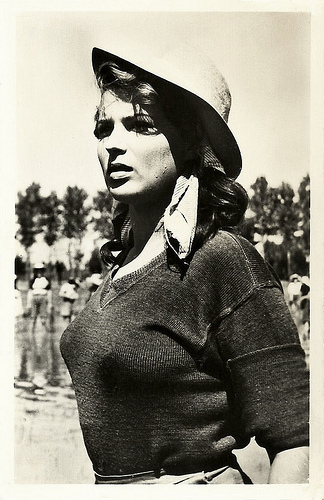
Dutch postcard by Filmverhuurkantoor Centrafilm, Dordrecht.
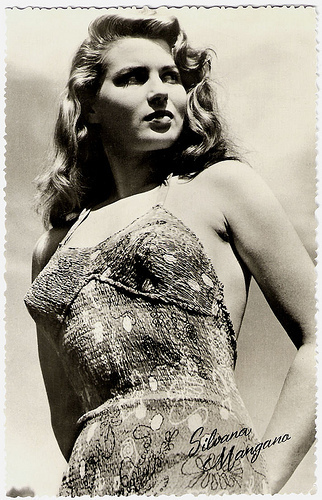
Dutch postcard by DRC, no. F 196. Photo: Lux Film.
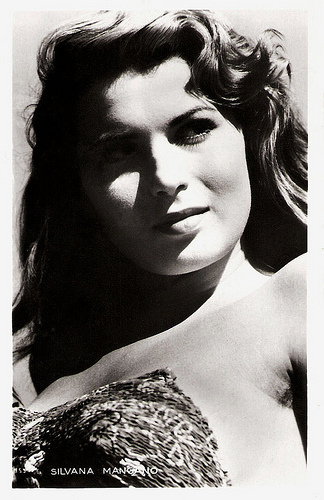
French postcard by Editions P.I., no. 159.
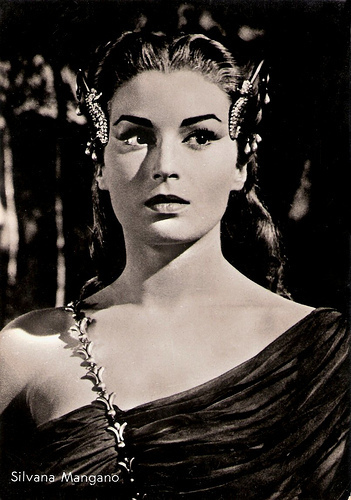
Italian postcard by Bromostampa, Milano (Milan), no. 37. Photo: still from Ulisse/Ulysses (Mario Camerini, 1954), produced by Silvana's husband, Dino De Laurentiis.
Shocking Hotpants
Silvana Mangano was born in Rome in 1930 to an Italian father, a Sicilian train conductor, and an English mother. Her brother is sound technician Roy Mangano and her sisters are one-time actresses Patrizia Mangano and Natascia Mangano. Silvana grew up in poverty caused by the Second World War. Trained for seven years as a dancer, she was supporting herself as a model. At 16, she won the Miss Rome beauty contest in 1946 and got a small role in the opera adaptation L'Elisir d'amore/Elixir of Love (Mario Costa, 1948) with Tito Gobbi. She was also nominated for the Miss Italia contest in 1947, which Lucia Bosé won. Mangano started to play small roles in films like Il delitto di Giovanni Episcopo/Flesh Will Surrender (Alberto Lattuada, 1947), Gli uomini sono nemici/Crossroads of Passion (1948, Ettore Giannini) with French diva Viviane Romance, and Black Magic (Gregory Ratoff, 1949) starring Orson Welles. She had her breakthrough with the neo-realistic crime story Riso amaro/Bitter Rice (Giuseppe De Santis, 1949), situated in the rice fields along the Po river in Northern Italy. Managano played the voluptuous rice picker Silvana, who falls for the criminal Walter (Vittorio Gassman) and his presumed wealth. The thousands of female rice workers, up to their ankles in the water, breaking their backs in the burning sun to earn a few bucks, make an impressive decor. To the standards of 1949s Roman Catholic Italy Mangano's performance in hotpants was shocking. This earned Riso Amaro a lot of publicity, and earned Mangano a contract with the Lux company.
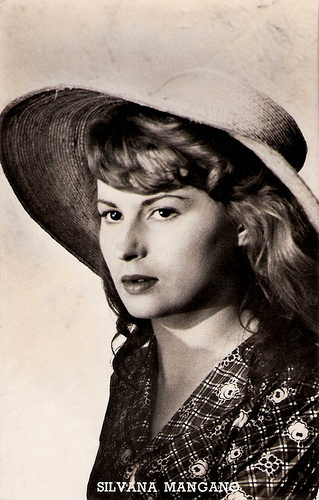
French postcard, no. 850. Photo: Lux Film.
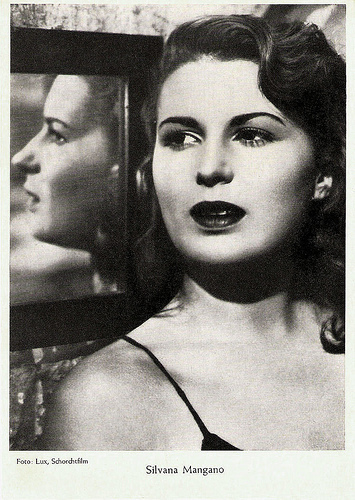
German collectors card. Photo: Lux / Schorchtfilm.
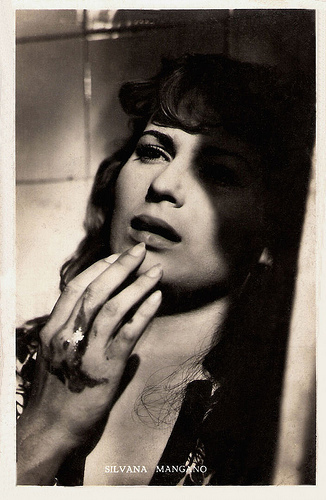
Belgian postcard by Nieuwe Merksemsche Chocolaterie, Merksem. Photo: Lux Film Rome. Publicity still for Riso Amaro/Bitter Rice (1949).
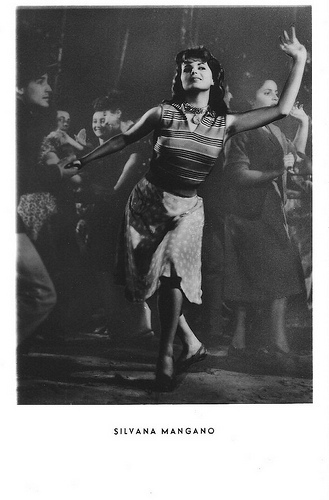
German postcard by Netter's Star Verlag, Berlin. Publicity still for Riso Amaro/Bitter Rice (1949).
Pig-fancying Enchantress
Though Silvana Mangano never scaled the heights of her competitors Sophia Loren and Gina Lollobrigida, she was a popular European film star in the 1950s and 1960s. Lux produced her subsequent films such as Anna (Alberto Lattuada, 1951) with Raf Vallone, and Ulisse/Ulysses (Mario Camerini, 1954), an adaptation of Homer's second epic featuring Kirk Douglas. Mangano played both Ulysses' faithful wife Penelope and the pig-fancying enchantress Circe. In 1949, she had married producer Dino De Laurentiis who controlled her career and launched her as the leading lady of international co-productions such as Mambo (Robert Rossen, 1954) with Michael Rennie, This Angry Age/Le barrage sur le Pacifique (René Clément, 1958) with Anthony Perkins, and 5 Branded Woman/Jovanka e le altre (Martin Ritt, 1960) with Jeanne Moreau.
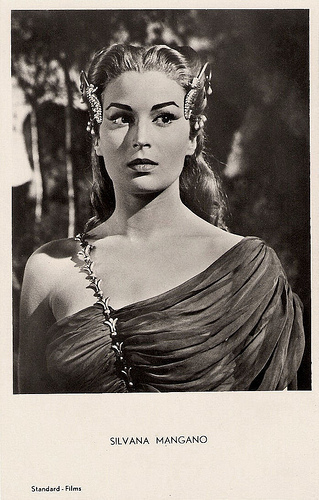
Dutch postcard, nr. 34. Photo: Standard-Films. Still from Ulisse/Ulysses (1954) in which Mangano played Circe/Penelope.
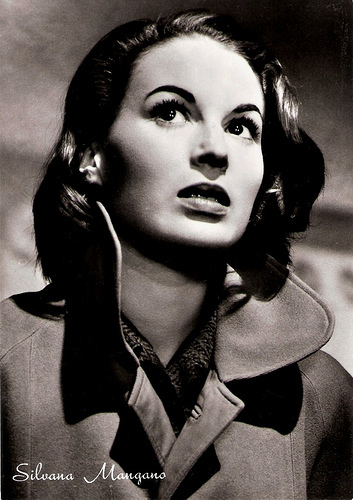
Italian postcard by Rotalfoto, Milano (Milan), no. 230.
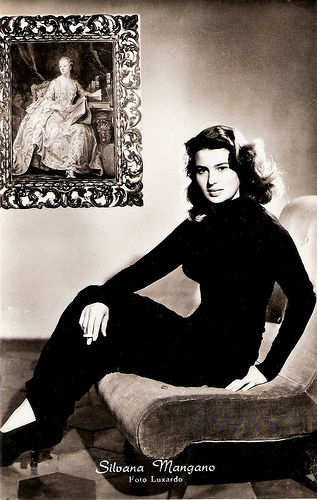
Dutch postcard, no. 857. Photo: Luxardo.
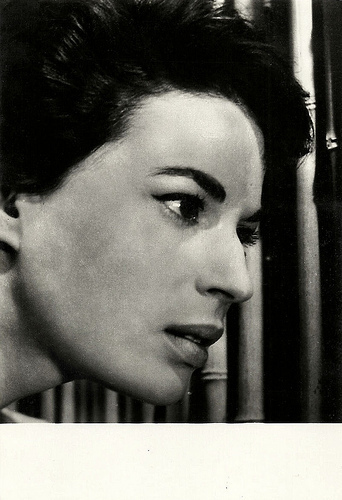
Italian postcard by Bromostampa, Milano in the series 'Hobby'.
Visconti and Pasolini
In 1967, Silvana Mangano starred in the anthology film Le streghe/The Witches (1967) with five episodes directed by Mauro Bolognini, Vittorio De Sica, Pier Paolo Pasolini, Franco Rossi and Luchino Visconti. Visconti shot the quite cynical and biographical episode La strega bruciata viva/The Witch Burned Alive, and he later cast her again as Tadzio's (Björn Andrésen) aristocratic mother in Morte a Venezia/Death in Venice (Luchino Visconti, 1971), modeled on Visconti's own mother. She also played the cunning Cosima von Bülow in Ludwig (Luchino Visconti, 1972), and the hysterical marchesa Brumonti in Gruppo di famiglia in un interno/Conversation Piece (Luchino Visconti, 1974) opposite Burt Lancaster. Mangano also performed in three films by Pasolini: as Jocaste in Edipo re/Oedipus Rex (Pier Paolo Pasolini, 1967), an updated version of the Greek tragedy by Sophocles; as Lucia, the mother in Teorema/Theorem (Pier Paolo Pasolini, 1968) with Terence Stamp, and as the Holy Virgin - a small, uncredited role - in Il Decameron/The Decameron (Pier Paolo Pasolini, 1971).
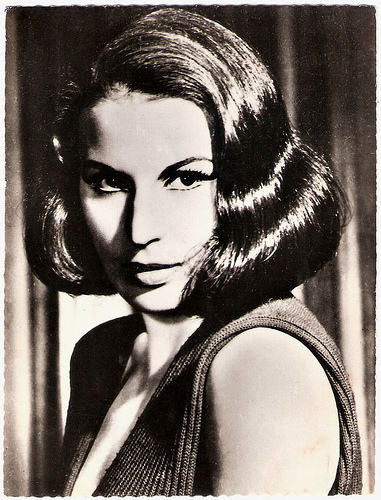
Vintage postcard, no. 2067.
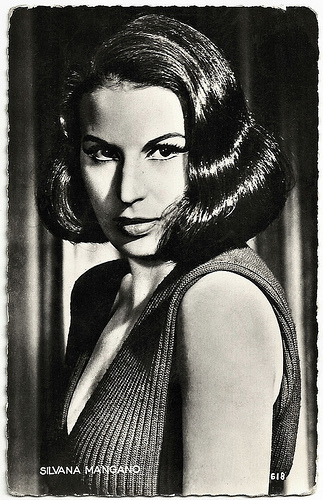
French postcard by Editions P.I., Paris, offered by Les Carbones Korès, no. 618.
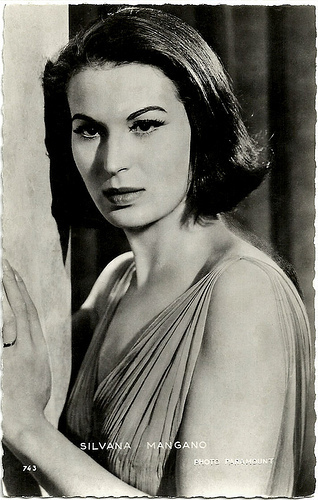
French postcard. Editions P.I., Paris, no. 743.
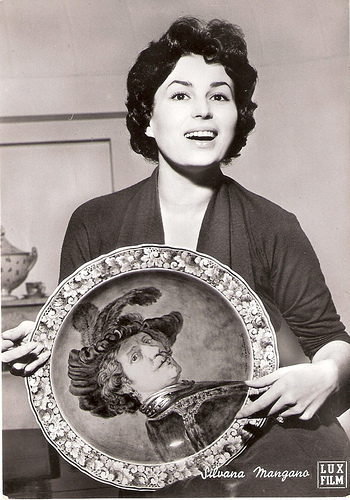
Italian postcard by Bromofoto, Milano. Photo: Lux Film. Mangano holds up a kitschy copy of a man's portrait (ca. 1635) by Dutch painter Rembrandt van Rijn, now at the Mauritshuis at the Hague.
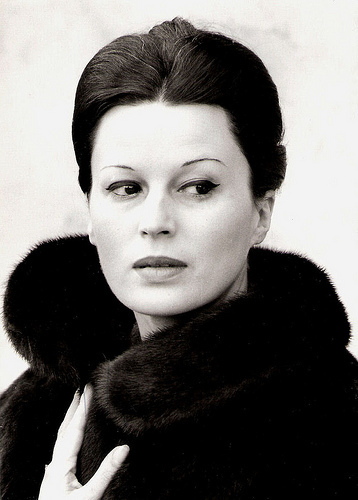
Italian postcard by Ferrania. Photo: Dino De Laurentiis Cinematografica.
Tapestries
In the 1980s, Silvana Mangano's life took a bad turn. In 1981 her son, Federico De Laurentiis, was killed in an Alaskan air crash. In 1983 she separated from Dino De Laurentiis , though they did not divorce. She did not perform in films anymore, except for Dune (David Lynch, 1984) and Oci ciornie/Dark Eyes (Nikita Mikhalkov, 1987), in which she played Romano's (Marcello Mastroianni) wife. She dedicated her time to making tapestries, alternating her domicile between Madrid and Paris. Silvana Mangano, who had always been a strong smoker, died of lung cancer in 1989, in a hospital in Madrid. She was only 59. Silvana Mangano had four children with Dino De Laurentiis: Veronica, Raffaella, Francesca, and the deceased Federico. Veronica's daughter Giada De Laurentiis is host of Everyday Italian on the Food Network. Raffaella coproduced with her father on Mangano's penultimate film, Dune.
Scene from Riso amaro/Bitter Rice (1949). Source: boct2007 (YouTube).
Scene from Anna (1951). Silvana sings El negro zumbon. Source: jack11anbar (YouTube).
Trailer of Morte a Venezia/Death in Venice (1971). Source: enneme (YouTube).
Sources: Hal Erickson (AllMovie), Wikipedia and

Dutch postcard by Filmverhuurkantoor Centrafilm, Dordrecht.

Dutch postcard by DRC, no. F 196. Photo: Lux Film.

French postcard by Editions P.I., no. 159.

Italian postcard by Bromostampa, Milano (Milan), no. 37. Photo: still from Ulisse/Ulysses (Mario Camerini, 1954), produced by Silvana's husband, Dino De Laurentiis.
Shocking Hotpants
Silvana Mangano was born in Rome in 1930 to an Italian father, a Sicilian train conductor, and an English mother. Her brother is sound technician Roy Mangano and her sisters are one-time actresses Patrizia Mangano and Natascia Mangano. Silvana grew up in poverty caused by the Second World War. Trained for seven years as a dancer, she was supporting herself as a model. At 16, she won the Miss Rome beauty contest in 1946 and got a small role in the opera adaptation L'Elisir d'amore/Elixir of Love (Mario Costa, 1948) with Tito Gobbi. She was also nominated for the Miss Italia contest in 1947, which Lucia Bosé won. Mangano started to play small roles in films like Il delitto di Giovanni Episcopo/Flesh Will Surrender (Alberto Lattuada, 1947), Gli uomini sono nemici/Crossroads of Passion (1948, Ettore Giannini) with French diva Viviane Romance, and Black Magic (Gregory Ratoff, 1949) starring Orson Welles. She had her breakthrough with the neo-realistic crime story Riso amaro/Bitter Rice (Giuseppe De Santis, 1949), situated in the rice fields along the Po river in Northern Italy. Managano played the voluptuous rice picker Silvana, who falls for the criminal Walter (Vittorio Gassman) and his presumed wealth. The thousands of female rice workers, up to their ankles in the water, breaking their backs in the burning sun to earn a few bucks, make an impressive decor. To the standards of 1949s Roman Catholic Italy Mangano's performance in hotpants was shocking. This earned Riso Amaro a lot of publicity, and earned Mangano a contract with the Lux company.

French postcard, no. 850. Photo: Lux Film.

German collectors card. Photo: Lux / Schorchtfilm.

Belgian postcard by Nieuwe Merksemsche Chocolaterie, Merksem. Photo: Lux Film Rome. Publicity still for Riso Amaro/Bitter Rice (1949).

German postcard by Netter's Star Verlag, Berlin. Publicity still for Riso Amaro/Bitter Rice (1949).
Pig-fancying Enchantress
Though Silvana Mangano never scaled the heights of her competitors Sophia Loren and Gina Lollobrigida, she was a popular European film star in the 1950s and 1960s. Lux produced her subsequent films such as Anna (Alberto Lattuada, 1951) with Raf Vallone, and Ulisse/Ulysses (Mario Camerini, 1954), an adaptation of Homer's second epic featuring Kirk Douglas. Mangano played both Ulysses' faithful wife Penelope and the pig-fancying enchantress Circe. In 1949, she had married producer Dino De Laurentiis who controlled her career and launched her as the leading lady of international co-productions such as Mambo (Robert Rossen, 1954) with Michael Rennie, This Angry Age/Le barrage sur le Pacifique (René Clément, 1958) with Anthony Perkins, and 5 Branded Woman/Jovanka e le altre (Martin Ritt, 1960) with Jeanne Moreau.

Dutch postcard, nr. 34. Photo: Standard-Films. Still from Ulisse/Ulysses (1954) in which Mangano played Circe/Penelope.

Italian postcard by Rotalfoto, Milano (Milan), no. 230.

Dutch postcard, no. 857. Photo: Luxardo.

Italian postcard by Bromostampa, Milano in the series 'Hobby'.
Visconti and Pasolini
In 1967, Silvana Mangano starred in the anthology film Le streghe/The Witches (1967) with five episodes directed by Mauro Bolognini, Vittorio De Sica, Pier Paolo Pasolini, Franco Rossi and Luchino Visconti. Visconti shot the quite cynical and biographical episode La strega bruciata viva/The Witch Burned Alive, and he later cast her again as Tadzio's (Björn Andrésen) aristocratic mother in Morte a Venezia/Death in Venice (Luchino Visconti, 1971), modeled on Visconti's own mother. She also played the cunning Cosima von Bülow in Ludwig (Luchino Visconti, 1972), and the hysterical marchesa Brumonti in Gruppo di famiglia in un interno/Conversation Piece (Luchino Visconti, 1974) opposite Burt Lancaster. Mangano also performed in three films by Pasolini: as Jocaste in Edipo re/Oedipus Rex (Pier Paolo Pasolini, 1967), an updated version of the Greek tragedy by Sophocles; as Lucia, the mother in Teorema/Theorem (Pier Paolo Pasolini, 1968) with Terence Stamp, and as the Holy Virgin - a small, uncredited role - in Il Decameron/The Decameron (Pier Paolo Pasolini, 1971).

Vintage postcard, no. 2067.

French postcard by Editions P.I., Paris, offered by Les Carbones Korès, no. 618.

French postcard. Editions P.I., Paris, no. 743.

Italian postcard by Bromofoto, Milano. Photo: Lux Film. Mangano holds up a kitschy copy of a man's portrait (ca. 1635) by Dutch painter Rembrandt van Rijn, now at the Mauritshuis at the Hague.

Italian postcard by Ferrania. Photo: Dino De Laurentiis Cinematografica.
Tapestries
In the 1980s, Silvana Mangano's life took a bad turn. In 1981 her son, Federico De Laurentiis, was killed in an Alaskan air crash. In 1983 she separated from Dino De Laurentiis , though they did not divorce. She did not perform in films anymore, except for Dune (David Lynch, 1984) and Oci ciornie/Dark Eyes (Nikita Mikhalkov, 1987), in which she played Romano's (Marcello Mastroianni) wife. She dedicated her time to making tapestries, alternating her domicile between Madrid and Paris. Silvana Mangano, who had always been a strong smoker, died of lung cancer in 1989, in a hospital in Madrid. She was only 59. Silvana Mangano had four children with Dino De Laurentiis: Veronica, Raffaella, Francesca, and the deceased Federico. Veronica's daughter Giada De Laurentiis is host of Everyday Italian on the Food Network. Raffaella coproduced with her father on Mangano's penultimate film, Dune.
Scene from Riso amaro/Bitter Rice (1949). Source: boct2007 (YouTube).
Scene from Anna (1951). Silvana sings El negro zumbon. Source: jack11anbar (YouTube).
Trailer of Morte a Venezia/Death in Venice (1971). Source: enneme (YouTube).
Sources: Hal Erickson (AllMovie), Wikipedia and
Published on July 03, 2013 23:00
July 2, 2013
John Stuart
We're still in Italy and enjoy
Il Cinema Ritrovato
(29 June - 6 July 2013). In the section Silent Hitch, Alfred Hitchcock's nine surviving silent films are screened. The collection starts with his debut, the sensational The Pleasure Garden (1925), a newly born film which was believed to be lost for many years. Male star of The Pleasure Garden is the Scottish actor John Stuart (1898-1979), a very popular leading man in British silent films in the 1920s.
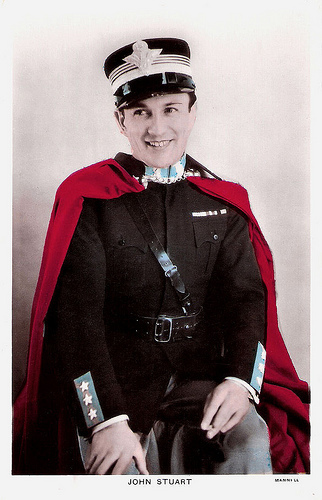
British postcard in the Colourgraph Series, London, no. C. 237. Photo: Mannell.
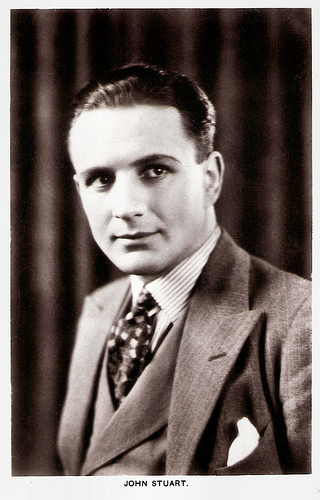
British postcard in the Picturegoer Series, London, no. 54c.
Instant Star
John Stuart was born John Alfred Louden Croall in Edinburgh, Scotland in 1898. He began his stage and screen career directly after World War I service in The Black Watch. He made his film debut in the drama The Lights of Home (Fred Paul, 1920). Other silent films were the drama If Four Walls Told (Fred Paul, 1922) starring Lillian Hall-Davis, the comedy The School for Scandal (Bertram Phillips, 1923) with Queenie Thomas, and the comedy We Women (W.P. Kellino, 1925). Stuart was a very popular leading man in British silent films, though it's hard to gauge that popularity since many of his best films of the 1920s, such as A Sporting Double (Arthur Rooke, 1923), Constant Hot Water (George A. Cooper, 1924) and The Tower of London (Maurice Elvey, 1926) with Isobel Elsom, are either inaccessible or non-existent. He appeared in a silent film directed by Alfred Hitchcock. The Pleasure Garden (1925) was Hitchcock’s directorial debut. Based on a novel by Oliver Sandys, the film is about two chorus girls at the Pleasure Garden Theatre in London and their troubled relationships. Glamorous American star Virginia Valli played the lead. The film was shot in Italy and Germany in 1925 and shown to the British press in March 1926. But it was not officially released in the UK until 1927, after Hitchcock's film The Lodger: A Story of the London Fog became a massive hit in February 1927. Stuart worked several times with director Maurice Elvey. Very popular was their World War I drama Mademoiselle from Armentieres (Maurice Elvey, 1926), featuring Estelle Brody. The film opened in London in September 1926 and was still playing in cinemas around the country until well into 1927. It was reportedly the most profitable British film of 1926 and made an instant star of Brody. The two stars were reunited in the drama Hindle Wakes (Maurice Elvey, 1927), which skilful use of location is considered to give the film a documentary realism feel very unusual in British films of the period. Brody and Stuart co-starred again in Mademoiselle Parley Voo (Maurice Elvey, 1928), a sequel to Mademoiselle from Armentieres, and equally successful. By the way, both films refer to the popular First World War song Mademoiselle from Armentières.

Lillian Hall-Davis German postcard by Ross Verlag, Berlin, no. 1479/2, 1927-1928. Photo: Ufa.
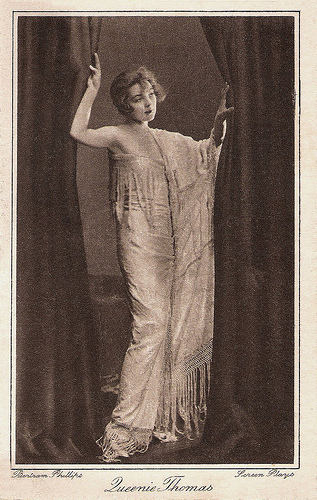
Queenie Thomas. British postcard in the series Screen Plays. Photo: Bertram Phillips.
Number Seventeen
John Stuart’s first sound film, Kitty (Victor Saville, 1929) was another successful production. Kitty was initially planned and filmed as a silent, but on its original completion director Saville decided to reshoot the latter part with sound. As no suitable facilities were yet available in Britain, Saville, Estelle Brody and Stuart travelled to New York to shoot the new sequences at RKO Studios. The film was released in the form of a silent which switched to sound after the half-way point. Stuart’s next film, Atlantic (1929) was one of the first British films made with the soundtrack optically recorded on the film (sound-on-film). Atlantic was directed and produced by Ewald André Dupont. Three versions were made, an English and a German language version, Atlantik, which were shot simultaneously, and later a French version was made. In England, Atlantic was released in both sound and silent prints. The film was originally made as Titanic but after lawsuits it was renamed Atlantic. The White Star Line, which owned the RMS Titanic, was still in operation at the time. The final scene of the film was filmed as a shot of the liner sinking but it was cut at the last minute as it was feared it would upset Titanic survivors. Then Stuart worked for a second time with Alfred Hitchcock, although indirectly. Elstree Calling (1930) is a lavish musical film revue directed by Andre Charlot, Jack Hulbert, Paul Murray, and Hitchcock at Elstree Studios. It was Britain's answer to the Hollywood revues, such as Paramount on Parade (Dorothy Arzner et al, 1930) and The Hollywood Review of 1929 (Charles Reisner, 1929). Stuart was not appearing in the segments directed by Hitchcock. They really worked together again on Number Seventeen (Alfred Hitchcock, 1932), in which Stuart played the lead. The film is about a group of criminals who committed a jewel robbery and put their money in an old house over a railway leading to the English Channel, the film's title being derived from the house's street number. An outsider stumbles onto this plot and intervenes with the help of a neighbour, a police officer's daughter. On its initial release, audiences reacted to Number Seventeen with confusion and disappointment. Stuart then played Sir Henry Baskerville in the mystery The Hound of the Baskervilles (Gareth Gundrey, 1932), based on the novel by Arthur Conan Doyle and scripted by Edgar Wallace. He was the co-star of Brigitte Helm in The Mistress of Atlantis (Georg Wilhelm Pabst, 1932), the English language version of the German-French adventure and fantasy film L'Atlantide/Die Herrin von Atlantis (Georg Wilhelm Pabst, 1932) based on the novel L'Atlantide by Pierre Benoît.
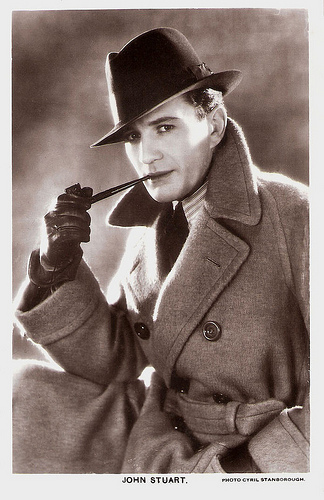
British postcard in the Picturegoer Series, London, no. 54e.
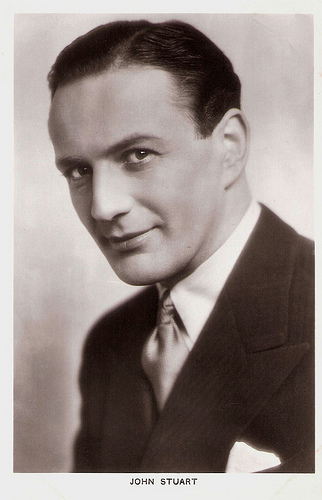
British postcard in the Picturegoer Series, London, no. 54e.
Quota Quickie
John Stuart starred with Benita Hume in the drama Men of Steel (George King, 1932). It was made at Nettlefold Studios under the so-called quota quickie system for distribution by United Artists. In 1927, The Cinematograph Films Act was designed to stimulate the declining British film industry. It introduced a requirement for British cinemas to show a quota of British films, for a duration of 10 years. The result of the act was the 'quota quickie', a low-cost, poor-quality film commissioned by American distributors operating in the UK purely to satisfy the quota requirements. During the 1930s Stuart appeared in a lot of these films. memorable are the drama The Lost Chord (Maurice Elvey, 1933) with Elizabeth Allan and Jack Hawkins, the comedy This Week of Grace Chord (Maurice Elvey, 1933) starring Gracie Fields and Henry Kendall, and Anglo-Italian aviation drama The Blue Squadron (George King, 1934) with Esmond Knight. Stuart co-starred with Fritz Kortner and Nils Asther in Abdul the Damned (Karl Grune, 1935), set in the Ottoman Empire in the years before the First World War where the Sultan and the Young Turks battle for power. He also worked often with director George Pearson, like in the thriller The Secret Voice (1936), and appeared in several parts of the long-running Old Mother Riley series. During the war years, Stuart’s parts became smaller or better said, he matured into character parts. He played a supporting part in the thriller Headline (John Harlow, 1944) with David Farrar as a crime reporter who searches for a mystery woman (Anne Crawford) who has witnessed a murder. Another example is the Gainsborough melodrama Madonna of the Seven Moons (Arthur Crabtree, 1945) starring Phyllis Calvert, Stewart Granger and Patricia Roc. In 1946 readers of the Daily Mail voted the film their third most popular British movie from 1939 to 1945. During the following decades he played government officials and police inspectors in B-films like the mystery The Ringer (Guy Hamilton, 1952) starring Herbert Lom, and the Science-fiction film Four Sided Triangle (Terence Fisher, 1953). Memorable are the war film Sink the Bismarck! (Lewis Gilbert, 1960) with Kenneth More, the Science-fiction film Village of the Damned (Wolf Rilla, 1960), and the suspense film Paranoiac (Freddie Francis, 1963) from Hammer Films and starring Janette Scott and Oliver Reed. Stuart now only played bit roles. His last part was a cameo in Superman (Richard Donner, 1978). In 1979, John Stuart died in London at the age of 81. He is buried in Brompton Cemetery, London. An accomplished writer, John Stuart penned his autobiography, Caught in the Act, in 1971. His son Jonathan Croall is writing a book about the screen idols of the 1920s, including John Stuart.
Trailer The Pleasure Garden (1925). Source: BFIfilms (YouTube).
Scene from Number Seventeen (1932). Source: TheLadyPhantom (YouTube).
Sources: Hal Erickson (AllMovie), Wikipedia and

British postcard in the Colourgraph Series, London, no. C. 237. Photo: Mannell.

British postcard in the Picturegoer Series, London, no. 54c.
Instant Star
John Stuart was born John Alfred Louden Croall in Edinburgh, Scotland in 1898. He began his stage and screen career directly after World War I service in The Black Watch. He made his film debut in the drama The Lights of Home (Fred Paul, 1920). Other silent films were the drama If Four Walls Told (Fred Paul, 1922) starring Lillian Hall-Davis, the comedy The School for Scandal (Bertram Phillips, 1923) with Queenie Thomas, and the comedy We Women (W.P. Kellino, 1925). Stuart was a very popular leading man in British silent films, though it's hard to gauge that popularity since many of his best films of the 1920s, such as A Sporting Double (Arthur Rooke, 1923), Constant Hot Water (George A. Cooper, 1924) and The Tower of London (Maurice Elvey, 1926) with Isobel Elsom, are either inaccessible or non-existent. He appeared in a silent film directed by Alfred Hitchcock. The Pleasure Garden (1925) was Hitchcock’s directorial debut. Based on a novel by Oliver Sandys, the film is about two chorus girls at the Pleasure Garden Theatre in London and their troubled relationships. Glamorous American star Virginia Valli played the lead. The film was shot in Italy and Germany in 1925 and shown to the British press in March 1926. But it was not officially released in the UK until 1927, after Hitchcock's film The Lodger: A Story of the London Fog became a massive hit in February 1927. Stuart worked several times with director Maurice Elvey. Very popular was their World War I drama Mademoiselle from Armentieres (Maurice Elvey, 1926), featuring Estelle Brody. The film opened in London in September 1926 and was still playing in cinemas around the country until well into 1927. It was reportedly the most profitable British film of 1926 and made an instant star of Brody. The two stars were reunited in the drama Hindle Wakes (Maurice Elvey, 1927), which skilful use of location is considered to give the film a documentary realism feel very unusual in British films of the period. Brody and Stuart co-starred again in Mademoiselle Parley Voo (Maurice Elvey, 1928), a sequel to Mademoiselle from Armentieres, and equally successful. By the way, both films refer to the popular First World War song Mademoiselle from Armentières.

Lillian Hall-Davis German postcard by Ross Verlag, Berlin, no. 1479/2, 1927-1928. Photo: Ufa.

Queenie Thomas. British postcard in the series Screen Plays. Photo: Bertram Phillips.
Number Seventeen
John Stuart’s first sound film, Kitty (Victor Saville, 1929) was another successful production. Kitty was initially planned and filmed as a silent, but on its original completion director Saville decided to reshoot the latter part with sound. As no suitable facilities were yet available in Britain, Saville, Estelle Brody and Stuart travelled to New York to shoot the new sequences at RKO Studios. The film was released in the form of a silent which switched to sound after the half-way point. Stuart’s next film, Atlantic (1929) was one of the first British films made with the soundtrack optically recorded on the film (sound-on-film). Atlantic was directed and produced by Ewald André Dupont. Three versions were made, an English and a German language version, Atlantik, which were shot simultaneously, and later a French version was made. In England, Atlantic was released in both sound and silent prints. The film was originally made as Titanic but after lawsuits it was renamed Atlantic. The White Star Line, which owned the RMS Titanic, was still in operation at the time. The final scene of the film was filmed as a shot of the liner sinking but it was cut at the last minute as it was feared it would upset Titanic survivors. Then Stuart worked for a second time with Alfred Hitchcock, although indirectly. Elstree Calling (1930) is a lavish musical film revue directed by Andre Charlot, Jack Hulbert, Paul Murray, and Hitchcock at Elstree Studios. It was Britain's answer to the Hollywood revues, such as Paramount on Parade (Dorothy Arzner et al, 1930) and The Hollywood Review of 1929 (Charles Reisner, 1929). Stuart was not appearing in the segments directed by Hitchcock. They really worked together again on Number Seventeen (Alfred Hitchcock, 1932), in which Stuart played the lead. The film is about a group of criminals who committed a jewel robbery and put their money in an old house over a railway leading to the English Channel, the film's title being derived from the house's street number. An outsider stumbles onto this plot and intervenes with the help of a neighbour, a police officer's daughter. On its initial release, audiences reacted to Number Seventeen with confusion and disappointment. Stuart then played Sir Henry Baskerville in the mystery The Hound of the Baskervilles (Gareth Gundrey, 1932), based on the novel by Arthur Conan Doyle and scripted by Edgar Wallace. He was the co-star of Brigitte Helm in The Mistress of Atlantis (Georg Wilhelm Pabst, 1932), the English language version of the German-French adventure and fantasy film L'Atlantide/Die Herrin von Atlantis (Georg Wilhelm Pabst, 1932) based on the novel L'Atlantide by Pierre Benoît.

British postcard in the Picturegoer Series, London, no. 54e.

British postcard in the Picturegoer Series, London, no. 54e.
Quota Quickie
John Stuart starred with Benita Hume in the drama Men of Steel (George King, 1932). It was made at Nettlefold Studios under the so-called quota quickie system for distribution by United Artists. In 1927, The Cinematograph Films Act was designed to stimulate the declining British film industry. It introduced a requirement for British cinemas to show a quota of British films, for a duration of 10 years. The result of the act was the 'quota quickie', a low-cost, poor-quality film commissioned by American distributors operating in the UK purely to satisfy the quota requirements. During the 1930s Stuart appeared in a lot of these films. memorable are the drama The Lost Chord (Maurice Elvey, 1933) with Elizabeth Allan and Jack Hawkins, the comedy This Week of Grace Chord (Maurice Elvey, 1933) starring Gracie Fields and Henry Kendall, and Anglo-Italian aviation drama The Blue Squadron (George King, 1934) with Esmond Knight. Stuart co-starred with Fritz Kortner and Nils Asther in Abdul the Damned (Karl Grune, 1935), set in the Ottoman Empire in the years before the First World War where the Sultan and the Young Turks battle for power. He also worked often with director George Pearson, like in the thriller The Secret Voice (1936), and appeared in several parts of the long-running Old Mother Riley series. During the war years, Stuart’s parts became smaller or better said, he matured into character parts. He played a supporting part in the thriller Headline (John Harlow, 1944) with David Farrar as a crime reporter who searches for a mystery woman (Anne Crawford) who has witnessed a murder. Another example is the Gainsborough melodrama Madonna of the Seven Moons (Arthur Crabtree, 1945) starring Phyllis Calvert, Stewart Granger and Patricia Roc. In 1946 readers of the Daily Mail voted the film their third most popular British movie from 1939 to 1945. During the following decades he played government officials and police inspectors in B-films like the mystery The Ringer (Guy Hamilton, 1952) starring Herbert Lom, and the Science-fiction film Four Sided Triangle (Terence Fisher, 1953). Memorable are the war film Sink the Bismarck! (Lewis Gilbert, 1960) with Kenneth More, the Science-fiction film Village of the Damned (Wolf Rilla, 1960), and the suspense film Paranoiac (Freddie Francis, 1963) from Hammer Films and starring Janette Scott and Oliver Reed. Stuart now only played bit roles. His last part was a cameo in Superman (Richard Donner, 1978). In 1979, John Stuart died in London at the age of 81. He is buried in Brompton Cemetery, London. An accomplished writer, John Stuart penned his autobiography, Caught in the Act, in 1971. His son Jonathan Croall is writing a book about the screen idols of the 1920s, including John Stuart.
Trailer The Pleasure Garden (1925). Source: BFIfilms (YouTube).
Scene from Number Seventeen (1932). Source: TheLadyPhantom (YouTube).
Sources: Hal Erickson (AllMovie), Wikipedia and
Published on July 02, 2013 23:00
July 1, 2013
Yves Montand
At
Il Cinema Ritrovato
(29 June - 6 July 2013), one of the sections is Letters from Chris Marker. His essay film came to light after a gestation period which happened to be a very special one, the golden age of the French short film in the 1950s. Bologna's tribute to Marker will focus on his early works, like Un dimanche à Pekin, Description d'un combat (which, according the festival organisation, has disappeared from the face of the earth for almost 50 years), La jeté and Le joli mai. Narrator of Le joli mai/The Beautiful May (1963) is French film actor Yves Montand (1921-1991). Italian-born but thoroughly French Montand was a charismatic singer and also a great actor - or was he an actor who also was a great singer? He represented the ideal of the working class hero with a strong social conscience. Montand starred in numerous successful films and his crooner songs, especially those about Paris, became instant classics. But his life was filled with controversy.
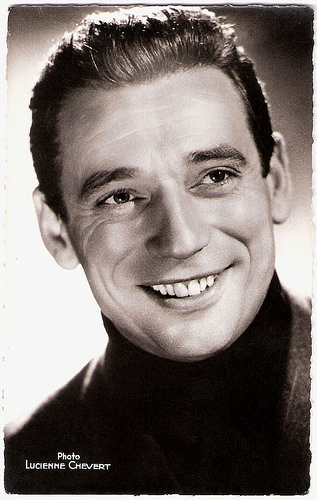
French postcard by Editions du Globe, Paris, no. 423. Photo: Lucienne Chevert.
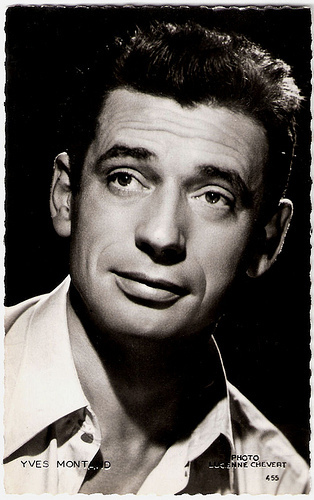
French postcard by Editions P.I., Paris, no. 455. Photo: Lucienne Chevert or Sam Lévin?. The credits for this photo differ. See the other cards below.
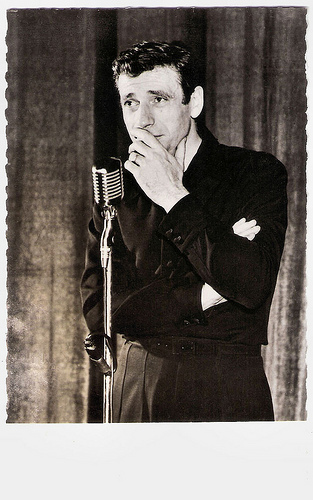
French postcard by Editions P.I., Paris, no. 913, presented by Les Carbones Korès 'Carboplane'. Photo: Studio Bernard et Vauclair.
Ivo! Monta!
Yves Montand was born Ivo Livi in 1921 in the village of Monsummano Alto, near Florence, Italy. He was the youngest of three children and his parents, Giovanni Livi and Giuseppina (later: Josephine) Livi-Simoni, were poor peasants. Giovanni was a militant communist and, to escape persecution from the new fascist regime of Mussolini in Italy, the family was forced to flee in 1923. They settled in Marseilles, and were granted French nationality in 1929 (one source says 1932). Ivo left school at 11 and, with the aid of a forged identity card, found a job in a food processing factory. At 14, he started working as a hairdresser at his sister's barber shop and obtained his qualification in hairdressing. When he was 17, he worked for a metal production company. By chance, the shy 17 year old agreed to do a stint as warm-up act in a music hall in 1938, for which he adopted the name Yves Montand. Legend has it that this stage name was inspired by his mother Giuseppina who used to yell at him when he was a boy when it was time to come upstairs: “Ivo! Monta!”. This first performance was a success - the audience applauded him for several minutes and shouted for an encore. That night in Marseilles a new French star was born. He performed at many small local venues, and at communist events. His father Giovanni was then a locally important figure in the French Communist Party in Marseille. Montand himself also had a strong social conscience. In 1950, he signed the 'Stockholm Appeal', the Soviet Union’s petition against the use of atomic weapons, and he became a prominent member of the French communist party. In 1956 and in 1963, he would tour as a jazz singer in the Soviet Union, and meet with Nikita Khrushchev. This caused a hail of criticism at home. In 1956, Soviet troops had just invaded Hungary, and Montand’s conscience was torn in two. He did not support the action of the Soviet government, but nor was he ready to make a political break from the Communist party and his own family. In the end Montand reluctantly agreed to go ahead with his Russian tour. He remained a Party member until 1968, when he broke with the Party in response to the Soviet invasion of Czechoslovakia.
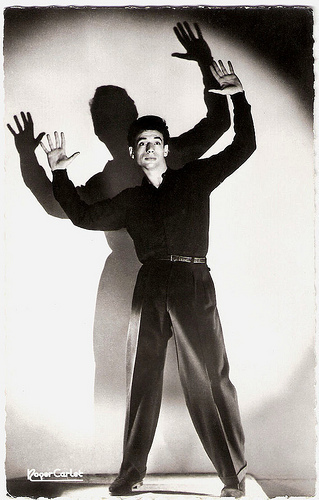
French postcard. Photo Roger Carlet.
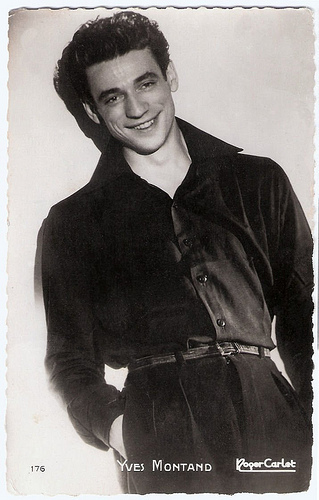
French postcard by Editions P.I., Paris, no. 176. Photo: Roger Carlet.
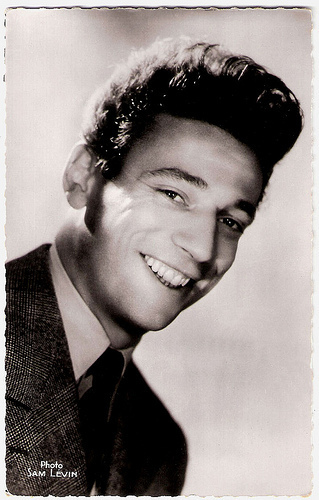
French postcard by Editions du Globe, Paris, no. 135. Photo: Sam Lévin.
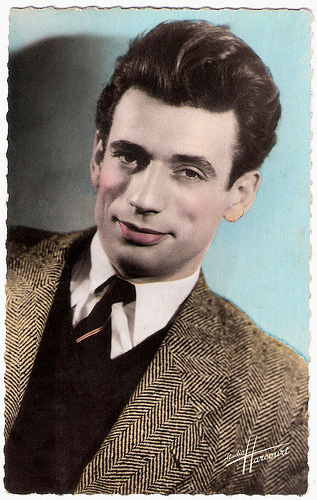
French postcard by Editions O.P., Paris, no. 11. Photo: Studio Harcourt.
Love Affairs
Yves Montand gave his first major concert in Marseilles on 21 June 1939, headlining at the famous Alcazar. It was here that Montand made a decisive step away from performing covers of other singers’ hits, singing his own original song Dans les plaines du Far West (In the plains of the Wild West). In 1944, Montand won a coveted spot at the Moulin Rouge, where he appeared as the support act of Édith Piaf. The legendary singer fell for his good looks and natural charisma, and she would soon become his mentor and lover. Their affair would last two years, and Piaf landed Montand his first film role, appearing along side her in Étoile sans lumière/Star Without Light (Marcel Blistène, 1945). Montand’s remarkable success from 1945 onwards is attributable to Piaf’s influence. Hits like Battling Joe and Les Grands Boulevards made Montand a national sensation almost overnight. In 1946, he appeared in his second film, Les Portes de la nuit/Gates of the Night (Marcel Carné, 1946) starring Pierre Brasseur. Despite being recognised now as a masterpiece, Carné's film was a commercial failure at the time. Further film appearances similarly failed to advance Montand's acting career. So he concentrated on his singing, which appeared to bring him far more success. In 1951, he staged his first one man show, which included 22 songs and two poems. It was a phenomenal success. In 1949, Montand had met rising young actress Simone Signoret, and the two fell in love. Having divorced her then husband, director Yves Allegrét, Signoret set up home with Montand in Paris in 1950 and the two married the following year. The marriage would last up until Signoret’s death in 1985, although Montand had a number of well-publicised love affairs, including one with Marilyn Monroe.
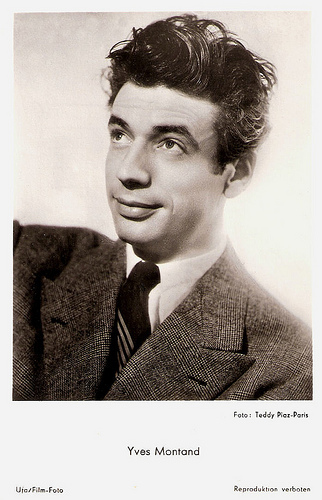
German postcard by Ufa/Film-Foto, Berlin-Tempelhof, no. FK 636. Photo: Teddy Piaz, Paris.
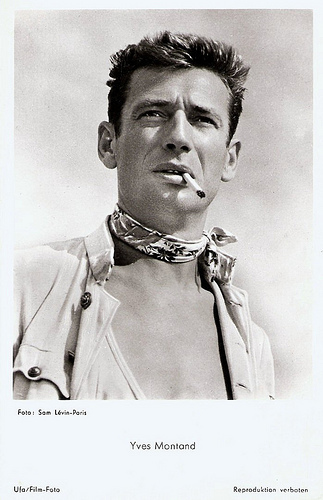
German postcard by Ufa (Universum-Film Aktiengesellschaft), Berlin-Tempelhof, no. FK 658. Retail price: 25 Pfg. Photo: Sam Lévin, Paris. Publicity still for Le salaire de la peur/The Wages of Fear (Henri-Georges Clouzot, 1953).
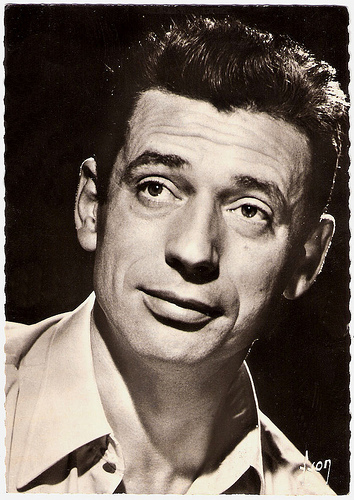
French postcard by Editions d'art Yvon, Paris, no. 189. Photo: Sam Lévin.
Prime Target for Hollywood
Despite his growing success as a singer, Yves Montand longed for a similar success in the cinema. In 1953, he took the starring role in the suspense thriller Le salaire de la peur/The Wages of Fear (Henri-Georges Clouzot, 1953), co-starring Charles Vanel. The film was hailed as a masterpiece by the international critics who also praised Montand’s performance. In 1953, Le salaire de la peur was awarded the coveted Grand Prix at the Cannes Film Festival. In 1954, Montand and Signoret starred in a French stage production of Arthur Miller’s The Crucible. Its success led to a film version a few years later, Les sorcières de Salem/The Witches of Salem (Raymond Rouleau, 1956) with Mylène Demongeot. By 1959, Yves Montand was an international celebrity. Montand appeared on Broadway, New York. and returned in 1961 at the Golden Theatre for an eight-week run. This was followed by a tour of Japan and England. He was by now a prime target for Hollywood and was cast alongside Marilyn Monroe in the romantic comedy Let’s Make Love (George Cukor, 1960). Montand’s much-publicised affair with Monroe threatened to tear his marriage apart at one point but he finally chose to remain with Simone, flying back to France to be near his wife. Although Let's Make Love was a flop, Montand would act in a number of American films, including Goodbye Again (Anatole Litvak, 1961) with Ingrid Bergman, My Geisha (Jack Cardiff, 1962) with Shirley MacLaine, and the musical On a Clear Day You Can See Forever (Vincente Minnelli, 1970) with Barbra Streisand.
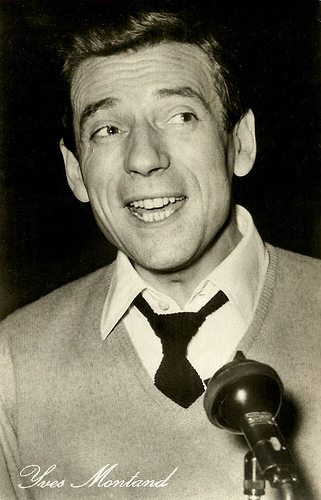
German postcard by VEB-Progress Film-Vertrieb, Berlin, no. 672. Photo: Gerhard Puhlmann,
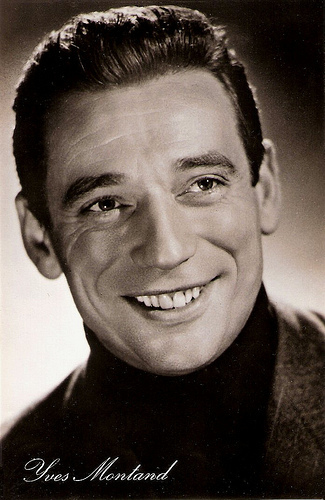
East-German postcard by VEB Progress Film-Vertrieb, Berlin, no. 807, 1958. Retail price: 0,20 DM.
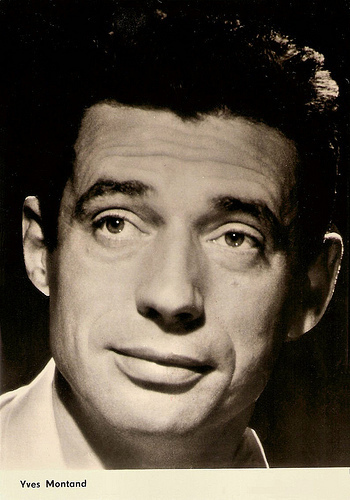
East-German postcard by VEB Progress Film-Vertrieb, Berlin, no. 2.558, 1966. Retail price: 0,20 MDN.
A Pure, Unadulterated Mediterranean
Despite having appeared in over a dozen films since Le Salaire de la peur, Yves Montand was still unsatisfied with his film career. This changed abruptly in the mid-1960's, when Montand’s success as a film actor began to rival his success as a singer. This began with Compartiment tueurs/The Sleeping Car Murders (1964), which was the first of four collaborations with the politically motivated Greek-born director Costa-Gavras. It was followed by high-profile films by some of France’s most acclaimed directors, including La guerre est finie/The War Is Over (Alain Resnais, 1966) with Ingrid Thulin, Paris brûle t’il ?/Is Paris Burning? (René Clément, 1967) starring Jean-Paul Belmondo, and the political thriller Z (Costa-Gavras, 1968). In September 1968, Montand gave a series of concerts at the Paris Olympia, which ran for six weeks. He had arrived, as a singer ánd as a film star. In the early 1970's, Montand appeared in a wide range of roles, alternating between tragic and comic: the thriller L’Aveu/The Confession (Costa-Gavras, 1970), the comedy La Folie des grandeurs/Delusions of Grandeur (Gérard Oury, 1971) co-starring with Louis de Funès, and the acclaimed romance César et Rosalie/César and Rosalie (Claude Sautet, 1972) opposite Romy Schneider. This latter film painted the truest picture of him: a pure, unadulterated Mediterranean - the big guy who never knew when to stop, as the anonymous author of the biographer at RFI Musique writes.
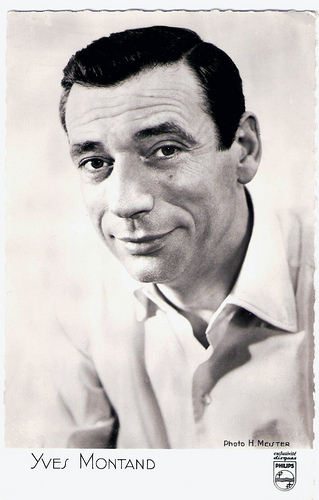
French postcard by Philips. Photo: H. Meister.
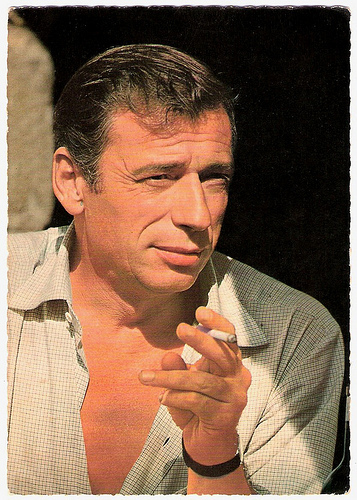
German postcard by Krüger, no. 902/394. Photo: Gerard Decaux.
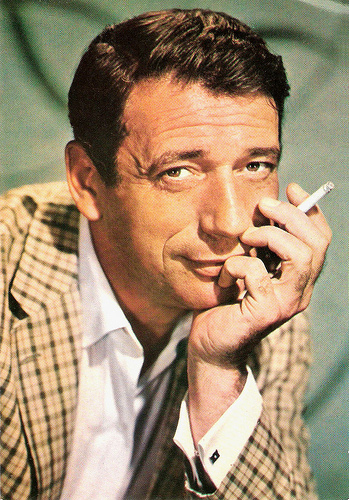
French card by Editions Vianelly, Paris, no. 7, 1968.
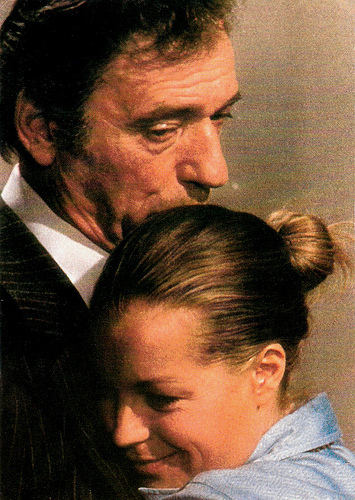
French postcard by Editions Nugeron in the Star Series, no. 58. Photo: publicity still for Clair de femme/Womanlight (Costa Gravas, 1979).
Spectacular Come-Back
Yves Montand was nominated for a Cesar Award for Best Actor for I comme Icare/I as in Icarus (Henri Verneuil, 1979) and again for Garçon!/Waiter! (Claude Sautet, 1983) with Nicole Garcia. In 1986, more than a decade after his international box-office draw power had diminished, the 65-year-old Montand came back spectacularly and gave one of his most memorable performances, as the scheming uncle in the two-part film: Jean de Florette (Claude Berri, 1986), co-starring Gérard Depardieu, and Manon des Sources/Manon of the Spring (1986, Claude Berri), co-starring Emmanuelle Béart. The film, adapted from the famous novel by the French author Marcel Pagnol, was a worldwide critical hit. In his later years he maintained a home in St Paul de Vence, Provence. On the last day of filming his final film, IP5:L'île aux pachydermes/IP5: The Island of Pachyderms (Jean-Jacques Beineix, 1992) with Olivier Martinez, he suffered a heart attack. (The film tells the story of an old man who dies from a heart attack.) Montand died a few hours later in a hospital in Senlis, France, on 9 November 1991. Like Simone Signoret, he is buried in the Cimetière du Père Lachaise (the Père Lachaisse Cemetery in Paris). Montand's only child, Valentin, his son by his second wife, his former personal assistant Carole Amiel, was born in 1988. His first marriage to Simone Signoret had been childless. Catherine Allégret, Signoret's daughter from her first marriage was Montand's adopted daughter. In 2004, Catherine Allégret published a book titled Un monde à l'envers/World Upside Down in which she contended that Montand had abused her sexually since she was five years old. There was more controversy after Montand's death. In a paternity suit that rocked France, a woman had accused Montand of being the father of her daughter and went to court to obtain a DNA sample from him. Montand had refused, but the woman persisted after his death. In a court ruling that made international headlines, the woman won the right to have Montand exhumed and a sample taken. On 11 March 1998, a paternity test showed that he wasn't the girl's father. Film critic James Travers concludes at Films de France : “Yves Montand, the myth and the man – the two are inextricably linked and one can never be sure where the one ends and the other begins”.
Yves Montand sings Les Feuilles Mortes (written by Jacques Prevert and Joseph Cosma) in the film Parigi è sempre Parigi/Paris is Always Paris (1951, Luciano Emmer) with Hélène Remy and Franco Interlenghi. Source: paccaggicco (YouTube).
Trailer of Let’s Make Love (1960). Source: Adore Marilyn (YouTube).
Scene from César et Rosalie/César and Rosalie (1972) with Yves Montand and Sami Frey. Source: Torteille (YouTube).
French trailer of Jean de Florette (1986). Source: Danios12345 (YouTube).
Yves Montand sings A Paris. Source: bpsconcept (YouTube).
Sources: James Travers (Films de France), Hal Erickson (AllMovie), RFI Musique, Wikipedia, and .

French postcard by Editions du Globe, Paris, no. 423. Photo: Lucienne Chevert.

French postcard by Editions P.I., Paris, no. 455. Photo: Lucienne Chevert or Sam Lévin?. The credits for this photo differ. See the other cards below.

French postcard by Editions P.I., Paris, no. 913, presented by Les Carbones Korès 'Carboplane'. Photo: Studio Bernard et Vauclair.
Ivo! Monta!
Yves Montand was born Ivo Livi in 1921 in the village of Monsummano Alto, near Florence, Italy. He was the youngest of three children and his parents, Giovanni Livi and Giuseppina (later: Josephine) Livi-Simoni, were poor peasants. Giovanni was a militant communist and, to escape persecution from the new fascist regime of Mussolini in Italy, the family was forced to flee in 1923. They settled in Marseilles, and were granted French nationality in 1929 (one source says 1932). Ivo left school at 11 and, with the aid of a forged identity card, found a job in a food processing factory. At 14, he started working as a hairdresser at his sister's barber shop and obtained his qualification in hairdressing. When he was 17, he worked for a metal production company. By chance, the shy 17 year old agreed to do a stint as warm-up act in a music hall in 1938, for which he adopted the name Yves Montand. Legend has it that this stage name was inspired by his mother Giuseppina who used to yell at him when he was a boy when it was time to come upstairs: “Ivo! Monta!”. This first performance was a success - the audience applauded him for several minutes and shouted for an encore. That night in Marseilles a new French star was born. He performed at many small local venues, and at communist events. His father Giovanni was then a locally important figure in the French Communist Party in Marseille. Montand himself also had a strong social conscience. In 1950, he signed the 'Stockholm Appeal', the Soviet Union’s petition against the use of atomic weapons, and he became a prominent member of the French communist party. In 1956 and in 1963, he would tour as a jazz singer in the Soviet Union, and meet with Nikita Khrushchev. This caused a hail of criticism at home. In 1956, Soviet troops had just invaded Hungary, and Montand’s conscience was torn in two. He did not support the action of the Soviet government, but nor was he ready to make a political break from the Communist party and his own family. In the end Montand reluctantly agreed to go ahead with his Russian tour. He remained a Party member until 1968, when he broke with the Party in response to the Soviet invasion of Czechoslovakia.

French postcard. Photo Roger Carlet.

French postcard by Editions P.I., Paris, no. 176. Photo: Roger Carlet.

French postcard by Editions du Globe, Paris, no. 135. Photo: Sam Lévin.

French postcard by Editions O.P., Paris, no. 11. Photo: Studio Harcourt.
Love Affairs
Yves Montand gave his first major concert in Marseilles on 21 June 1939, headlining at the famous Alcazar. It was here that Montand made a decisive step away from performing covers of other singers’ hits, singing his own original song Dans les plaines du Far West (In the plains of the Wild West). In 1944, Montand won a coveted spot at the Moulin Rouge, where he appeared as the support act of Édith Piaf. The legendary singer fell for his good looks and natural charisma, and she would soon become his mentor and lover. Their affair would last two years, and Piaf landed Montand his first film role, appearing along side her in Étoile sans lumière/Star Without Light (Marcel Blistène, 1945). Montand’s remarkable success from 1945 onwards is attributable to Piaf’s influence. Hits like Battling Joe and Les Grands Boulevards made Montand a national sensation almost overnight. In 1946, he appeared in his second film, Les Portes de la nuit/Gates of the Night (Marcel Carné, 1946) starring Pierre Brasseur. Despite being recognised now as a masterpiece, Carné's film was a commercial failure at the time. Further film appearances similarly failed to advance Montand's acting career. So he concentrated on his singing, which appeared to bring him far more success. In 1951, he staged his first one man show, which included 22 songs and two poems. It was a phenomenal success. In 1949, Montand had met rising young actress Simone Signoret, and the two fell in love. Having divorced her then husband, director Yves Allegrét, Signoret set up home with Montand in Paris in 1950 and the two married the following year. The marriage would last up until Signoret’s death in 1985, although Montand had a number of well-publicised love affairs, including one with Marilyn Monroe.

German postcard by Ufa/Film-Foto, Berlin-Tempelhof, no. FK 636. Photo: Teddy Piaz, Paris.

German postcard by Ufa (Universum-Film Aktiengesellschaft), Berlin-Tempelhof, no. FK 658. Retail price: 25 Pfg. Photo: Sam Lévin, Paris. Publicity still for Le salaire de la peur/The Wages of Fear (Henri-Georges Clouzot, 1953).

French postcard by Editions d'art Yvon, Paris, no. 189. Photo: Sam Lévin.
Prime Target for Hollywood
Despite his growing success as a singer, Yves Montand longed for a similar success in the cinema. In 1953, he took the starring role in the suspense thriller Le salaire de la peur/The Wages of Fear (Henri-Georges Clouzot, 1953), co-starring Charles Vanel. The film was hailed as a masterpiece by the international critics who also praised Montand’s performance. In 1953, Le salaire de la peur was awarded the coveted Grand Prix at the Cannes Film Festival. In 1954, Montand and Signoret starred in a French stage production of Arthur Miller’s The Crucible. Its success led to a film version a few years later, Les sorcières de Salem/The Witches of Salem (Raymond Rouleau, 1956) with Mylène Demongeot. By 1959, Yves Montand was an international celebrity. Montand appeared on Broadway, New York. and returned in 1961 at the Golden Theatre for an eight-week run. This was followed by a tour of Japan and England. He was by now a prime target for Hollywood and was cast alongside Marilyn Monroe in the romantic comedy Let’s Make Love (George Cukor, 1960). Montand’s much-publicised affair with Monroe threatened to tear his marriage apart at one point but he finally chose to remain with Simone, flying back to France to be near his wife. Although Let's Make Love was a flop, Montand would act in a number of American films, including Goodbye Again (Anatole Litvak, 1961) with Ingrid Bergman, My Geisha (Jack Cardiff, 1962) with Shirley MacLaine, and the musical On a Clear Day You Can See Forever (Vincente Minnelli, 1970) with Barbra Streisand.

German postcard by VEB-Progress Film-Vertrieb, Berlin, no. 672. Photo: Gerhard Puhlmann,

East-German postcard by VEB Progress Film-Vertrieb, Berlin, no. 807, 1958. Retail price: 0,20 DM.

East-German postcard by VEB Progress Film-Vertrieb, Berlin, no. 2.558, 1966. Retail price: 0,20 MDN.
A Pure, Unadulterated Mediterranean
Despite having appeared in over a dozen films since Le Salaire de la peur, Yves Montand was still unsatisfied with his film career. This changed abruptly in the mid-1960's, when Montand’s success as a film actor began to rival his success as a singer. This began with Compartiment tueurs/The Sleeping Car Murders (1964), which was the first of four collaborations with the politically motivated Greek-born director Costa-Gavras. It was followed by high-profile films by some of France’s most acclaimed directors, including La guerre est finie/The War Is Over (Alain Resnais, 1966) with Ingrid Thulin, Paris brûle t’il ?/Is Paris Burning? (René Clément, 1967) starring Jean-Paul Belmondo, and the political thriller Z (Costa-Gavras, 1968). In September 1968, Montand gave a series of concerts at the Paris Olympia, which ran for six weeks. He had arrived, as a singer ánd as a film star. In the early 1970's, Montand appeared in a wide range of roles, alternating between tragic and comic: the thriller L’Aveu/The Confession (Costa-Gavras, 1970), the comedy La Folie des grandeurs/Delusions of Grandeur (Gérard Oury, 1971) co-starring with Louis de Funès, and the acclaimed romance César et Rosalie/César and Rosalie (Claude Sautet, 1972) opposite Romy Schneider. This latter film painted the truest picture of him: a pure, unadulterated Mediterranean - the big guy who never knew when to stop, as the anonymous author of the biographer at RFI Musique writes.

French postcard by Philips. Photo: H. Meister.

German postcard by Krüger, no. 902/394. Photo: Gerard Decaux.

French card by Editions Vianelly, Paris, no. 7, 1968.

French postcard by Editions Nugeron in the Star Series, no. 58. Photo: publicity still for Clair de femme/Womanlight (Costa Gravas, 1979).
Spectacular Come-Back
Yves Montand was nominated for a Cesar Award for Best Actor for I comme Icare/I as in Icarus (Henri Verneuil, 1979) and again for Garçon!/Waiter! (Claude Sautet, 1983) with Nicole Garcia. In 1986, more than a decade after his international box-office draw power had diminished, the 65-year-old Montand came back spectacularly and gave one of his most memorable performances, as the scheming uncle in the two-part film: Jean de Florette (Claude Berri, 1986), co-starring Gérard Depardieu, and Manon des Sources/Manon of the Spring (1986, Claude Berri), co-starring Emmanuelle Béart. The film, adapted from the famous novel by the French author Marcel Pagnol, was a worldwide critical hit. In his later years he maintained a home in St Paul de Vence, Provence. On the last day of filming his final film, IP5:L'île aux pachydermes/IP5: The Island of Pachyderms (Jean-Jacques Beineix, 1992) with Olivier Martinez, he suffered a heart attack. (The film tells the story of an old man who dies from a heart attack.) Montand died a few hours later in a hospital in Senlis, France, on 9 November 1991. Like Simone Signoret, he is buried in the Cimetière du Père Lachaise (the Père Lachaisse Cemetery in Paris). Montand's only child, Valentin, his son by his second wife, his former personal assistant Carole Amiel, was born in 1988. His first marriage to Simone Signoret had been childless. Catherine Allégret, Signoret's daughter from her first marriage was Montand's adopted daughter. In 2004, Catherine Allégret published a book titled Un monde à l'envers/World Upside Down in which she contended that Montand had abused her sexually since she was five years old. There was more controversy after Montand's death. In a paternity suit that rocked France, a woman had accused Montand of being the father of her daughter and went to court to obtain a DNA sample from him. Montand had refused, but the woman persisted after his death. In a court ruling that made international headlines, the woman won the right to have Montand exhumed and a sample taken. On 11 March 1998, a paternity test showed that he wasn't the girl's father. Film critic James Travers concludes at Films de France : “Yves Montand, the myth and the man – the two are inextricably linked and one can never be sure where the one ends and the other begins”.
Yves Montand sings Les Feuilles Mortes (written by Jacques Prevert and Joseph Cosma) in the film Parigi è sempre Parigi/Paris is Always Paris (1951, Luciano Emmer) with Hélène Remy and Franco Interlenghi. Source: paccaggicco (YouTube).
Trailer of Let’s Make Love (1960). Source: Adore Marilyn (YouTube).
Scene from César et Rosalie/César and Rosalie (1972) with Yves Montand and Sami Frey. Source: Torteille (YouTube).
French trailer of Jean de Florette (1986). Source: Danios12345 (YouTube).
Yves Montand sings A Paris. Source: bpsconcept (YouTube).
Sources: James Travers (Films de France), Hal Erickson (AllMovie), RFI Musique, Wikipedia, and .
Published on July 01, 2013 23:00
June 30, 2013
Paul Hartmann
There were a number of films produced in Europe and the US in 1938-1939 which tangibly transmitted the feeling of menacing madness that was about to unfold.
Il Cinema Ritrovato
(29 June - 6 July 2013) chose for its series War Is Near: 1938-1939 not so much those films most clearly foreshadowing the imminent conflict, as those that evoked an atmosphere of fears and fragile hopes, films made of subtle suggestion, shades and shadows and unspoken dialogue.
One of the screened films in Bologna is the Nazi propaganda film Pour le Mérite (Karl Ritter, 1938), which chronicles the rise of the Luftwaffe (German Air Force) from World War I until Adolf Hitler took power in 1933. Star is the German stage actor Paul Hartmann (1889-1977). During his long career, Hartmann made over 100 films, both in the silent and the sound period. Despite his commitment to the Nazi regime, he could continue his career quite smoothly into the 1950s and 1960s.
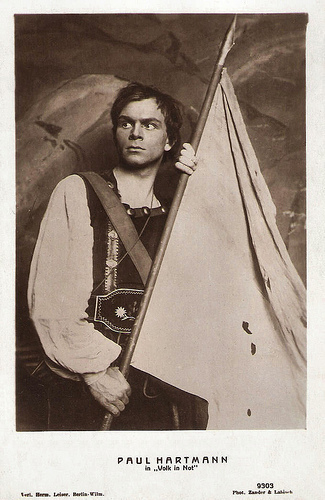
German postcard by Verlag Hermann Leiser, Berlin-Wilm., no. 9303. Photo: Zander & Labisch. Publicity still for Volk in Not/People in Need (Wolfgang Neff, 1925).
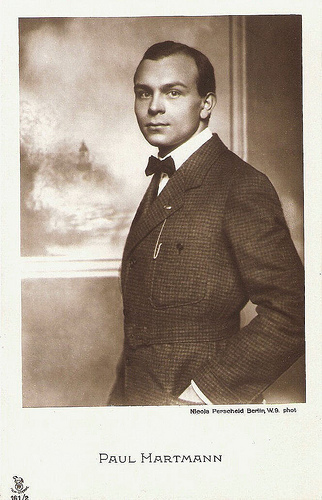
German postcard by Rotophot in the Film Sterne series, no. 161/2. Photo: Nicola Perscheid, Berlin.
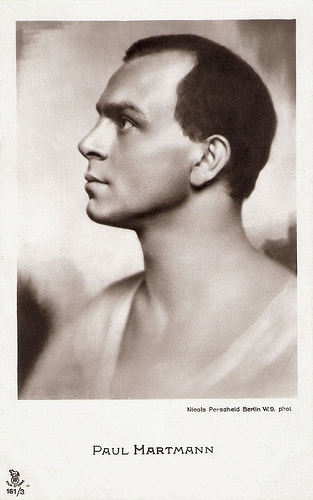
German postcard by Rotophot in the Film Sterne series, no. 161/3. Photo: Nicola Perscheid, Berlin.
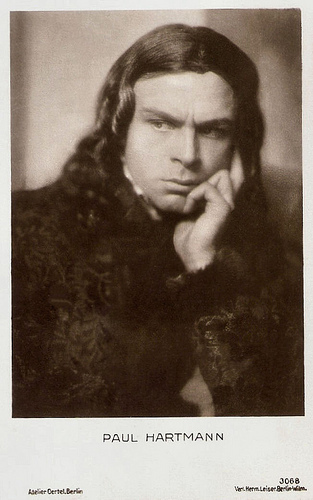
German postcard by Verl. Herm. Leiser, Berlin-Wilm., no. 3068. Photo: Atelier Oertel, Berlin.
Burgtheater
Paul Wilhelm Constantin Hartmann was born in Fürth, Germany in 1889. He was the son of Wilhelm Hartmann, the manager of a toy-export company, and his wife Maria Hartmann-Betz. From 1907 on, he studied acting with Adalbert Czokke, and in 1908 he had his first engagement at the Stadtheater Zwickau. In the following years he played at the Bellevue-Theater in Stettin, the Stadttheater Zürich, and from November 1913 at the Deutsche Theater in Berlin under direction of the legendary Max Reinhardt. He also started to work for the cinema. He made his film debut as a jeune premier in 1915 in Zofia - Kriegs-Irrfahrten eines Kindes/Zofia – the War Odysseys of a Child (Hubert Moest, 1915) with Ernst Pittschau and Hedda Vernon. Soon followed more films like Der Trick/The Trick (Fred Sauer, 1915) with Aud Egede Nissen, Die verschleierte Dame/The Veiled Lady (Richard Oswald, 1915), Ein Blatt Papier/A Page of Paper (Joe May, 1916), Feenhände/Hands of a Fairy (Rudolf Biebrach, 1916) with Henny Porten, the Harry Deebs detective Das Geheimnis der leeren Wasserflasche/The Secret of the Empty Water Bottle (Joe May, 1917) starring Harry Liedtke, Christa Hartungen (Rudolf Biebrach, 1917), and Es werde Licht!/Let There Be Light! (Richard Oswald, 1918). That same year, he appeared in Der Trompetter von Säkkingen/The Trumpeter of Säckingen (Franz Porten, 1918), based on a popular opera (1884) by Viktor Nessler, which in turn was based on a romantic book by Joseph Victor von Scheffel, published in 1854. The story is set in Heidelberg and Säckingen during the 17th century, after the Thirty Years War. Law student, later trumpeter Werner Kirchhof falls in love with Margareta, a baron's daughter, but her mother wants to marry her to the cowardly Damian. Werner proves to be a hero and a compassionate pope makes him marquis of Camposanto. Then, after five years of separation nothing can prevent a happy ending. Hartmann's stage and film career suffered a short break when he was called into the military service in 1917. After that he continued his film career smoothly. In the 1920s he played romantic and melancholic characters in films like Katharina die Grosse/Catherine the Great (Reinhold Schünzel, 1920) with Lucie Höflich, Anna Boleyn/Anne Boleyn (Ernst Lubitsch, 1920) with Emil Jannings and Henny Porten, Schloss Vogelöd/The Haunted Castle (Friedrich Wilhelm Murnau, 1921) with Olga Tschechova, Der Roman der Christine von Herre (Ludwig Berger, 1921) with Heinrich George, Luise Millerin (Carl Froelich, 1922) with Lil Dagover, Alt-Heidelberg/The Student Prince (Hans Behrendt, 1923) with Eva May, Zur Chronik von Grieshuus/The Chronicles of the Gray House (Arthur von Gerlach, 1925) and the silent film operetta Der Rosenkavalier/The Knight Of The Rose (Robert Wiene, 1925) with Jaque Catelain. In 1924 he worked at the Theater in der Josefstadt in Wien (Vienna), and in 1925 he moved over to the Burgtheater. From 1927 he turned away from the film business and devoted his career exclusively to the Burgtheater.
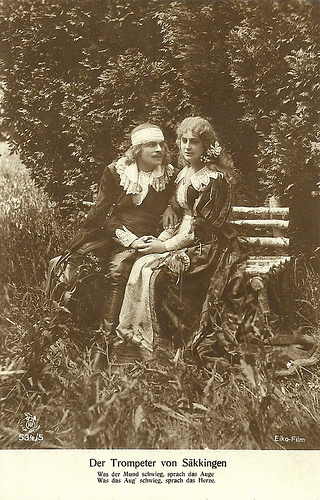
German postcard by Rotophot in the Series Film-Sterne, no. 534/5. Photo: Eiko-Film. Publicity still for Der Trompeter von Säkkingen (Franz Porten, 1918), starring Paul Hartmann. The outdoor scenes of the film were shot by Porten at Säckingen, using some 200 local extras.
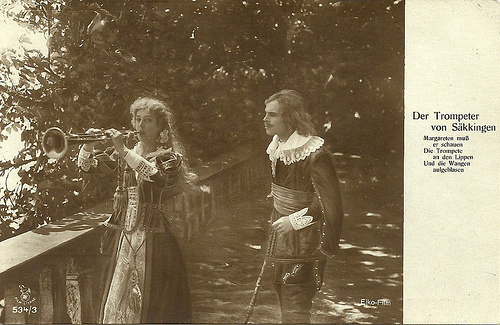
German postcard by Rotophot in the Series Film-Sterne, no. 534/3. Photo: Eiko-Film. Publicity still for Der Trompeter von Säkkingen (Franz Porten, 1918), starring Paul Hartmann.
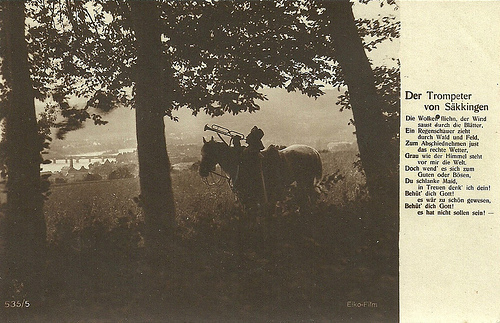
German postcard by Rotophot in the Series Film-Sterne, no. 535/5. Photo: Eiko-Film. Publicity still for Der Trompeter von Säkkingen (Franz Porten, 1918), starring Paul Hartmann.
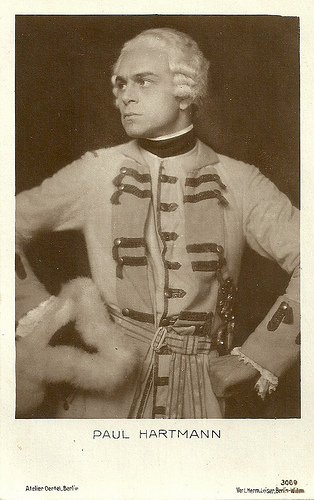
German postcard by Verlag Hermann Leiser, Berlin, no. 3069. Photo: Atelier Oertel, Berlin.
Tough and Adamant Heroes
With the introduction of the sound film Paul Hartmann returned to the cinema. He played tough and adamant heroes, like the constructor and captain next to Hans Albers in the deluxe German/British production F.P.1 antwortet nicht/F.P.1 Doesn't Answer (Karl Hartl, 1932), or as the self sacrificing engineer in Der Tunnel/The Tunnel (Kurt aka Curtis Bernhardt, 1933). Other popular films were Der Läufer von Marathon/The Marathon Runner (Ewald André Dupont, 1933), Salon Dora Green/The House of Dora Green (Henrik Galeen, 1933) with Alfred Abel, and Mazurka (Willi Forst, 1935) with Pola Negri. From 1935 on he was a company member of the Preußischen Staatstheater in Berlin, where he stayed till the end of WW II. In 1934 he was named Staatsschauspieler (Stage Artist of the State), and from May 1937 he was part of the UFA Art Committee. He also appeared in such propaganda films as Pour le mérite (Karl Ritter, 1938), the biography Bismarck (Wolfgang Liebeneiner, 1940) and Ich klage an/I Accuse (Wolfgang Liebeneiner, 1941). In April 1942 he became the president of the Reichstheaterkammer. His commitment to the Nazi regime did not really harm his career or his popularity after the war. After being banned from the theatre in 1945 Hartmann could only return to the stage in 1948 as Faust in a production of the Goethe play in Bonn. During the 1950s he was engaged by the Schauspielhaus in Düsseldorf, the Theater am Kurfürstendamm in Berlin, and the Burgtheater in Vienna. He also returned to the cinema. The ageing star now mainly worked as a character actor in supporting roles, such as in Die Dame in Schwarz/The Lady in Black (Erich Engels, 1951) with Mady Rahl, Der grosse Zapfenstreich/The Sergeant's Daughter (George Hurdalek, 1953) with Johanna Matz, Regina Amstetten (Kurt Neumann, 1954), Die Barrings/The Barrings (Rolf Thiele, 1955) with Dieter Borsche and Nadja Tiller, Der Fuchs von Paris/The Fox of Paris (Paul May, 1957), Buddenbrooks (Alfred Weidenmann, 1959), and Rosen für den Staatsanwalt/Roses for the Prosecutor (Wolfgang Staudte, 1959). He finished his film career in the 1960s with productions like the TV-film Hermann und Dorothea (Ludwig Berger, 1961), the Heimatfilm Waldrausch (Paul May, 1962), and the international war film The Longest Day (Ken Annakin, Andrew Marton, Bernhard Wicki, 1962), an all-star re-creation of the D-Day invasion, personally orchestrated by Darryl F. Zanuck. Hartmanns last appearance was in the TV-film Demetrius (Ludwig Berger, Heribert Wenk, 1969). In 1964 he was awarded the Filmband in Gold for his continuing and outstanding contributions to the German Film. Paul Hartmann died in 1977 in München (Munich). He was married twice. During WWI he had married a Slavic ballet dancer, who died in 1952. In 1955 he married the painter Elfriede Lieberun.
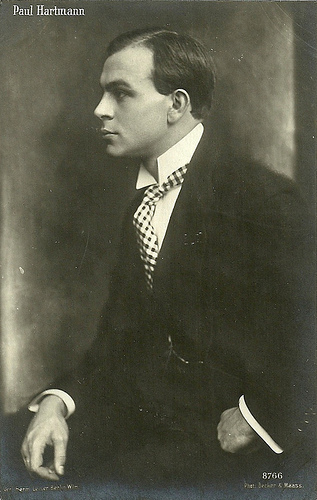
German postcard by Verlag Hermann Leiser, Berlin, no. 8766. Photo: Becker & Maass.
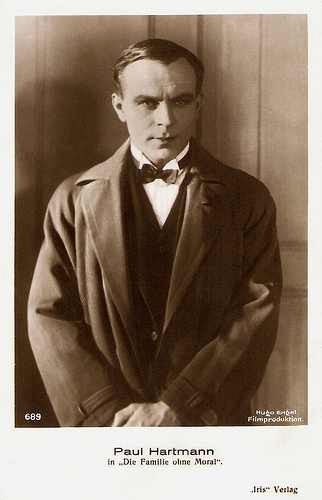
Austrian postcard by Iris Verlag, no. 689. Photo: Hugo Engel Filmproduktion. Publicity still for Die Familie ohne Moral/The family with no morals (Max Neufeld, 1927).
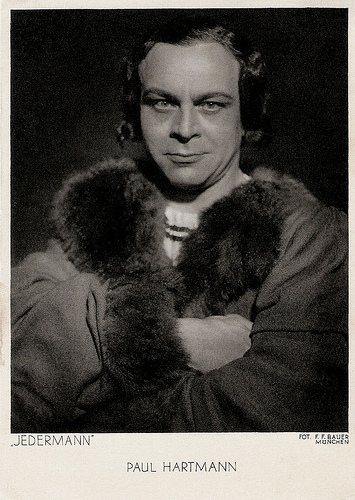
German postcard by Cozy Verlag, Salzburg. Photo: Friedrich Franz Bauer. Publicity still for the stage production Jedermann, performed at the Salzburger Festspiele.
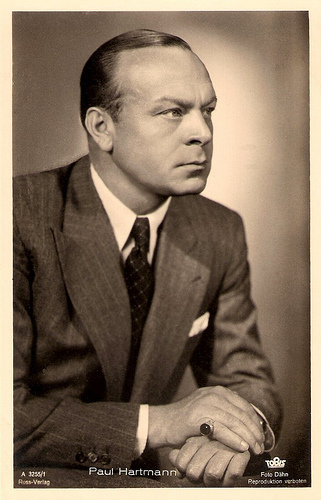
German postcard by Ross Verlag, no. A 3255/1, 1941-1944. Photo: Tobis / Foto Dähn.
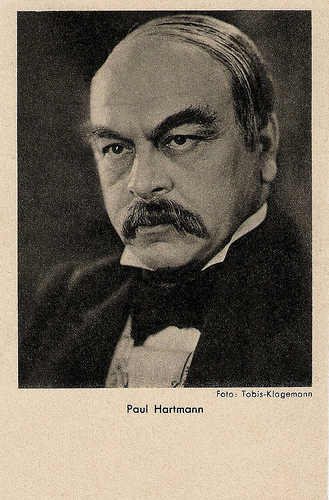
German postcard by Das Programm von Heute, Berlin. Photo: Tobis / Klagemann.
Sources: Thomas Staedeli (Cyranos), Hal Erickson (AllMovie), Wikipedia (German), and
One of the screened films in Bologna is the Nazi propaganda film Pour le Mérite (Karl Ritter, 1938), which chronicles the rise of the Luftwaffe (German Air Force) from World War I until Adolf Hitler took power in 1933. Star is the German stage actor Paul Hartmann (1889-1977). During his long career, Hartmann made over 100 films, both in the silent and the sound period. Despite his commitment to the Nazi regime, he could continue his career quite smoothly into the 1950s and 1960s.

German postcard by Verlag Hermann Leiser, Berlin-Wilm., no. 9303. Photo: Zander & Labisch. Publicity still for Volk in Not/People in Need (Wolfgang Neff, 1925).

German postcard by Rotophot in the Film Sterne series, no. 161/2. Photo: Nicola Perscheid, Berlin.

German postcard by Rotophot in the Film Sterne series, no. 161/3. Photo: Nicola Perscheid, Berlin.

German postcard by Verl. Herm. Leiser, Berlin-Wilm., no. 3068. Photo: Atelier Oertel, Berlin.
Burgtheater
Paul Wilhelm Constantin Hartmann was born in Fürth, Germany in 1889. He was the son of Wilhelm Hartmann, the manager of a toy-export company, and his wife Maria Hartmann-Betz. From 1907 on, he studied acting with Adalbert Czokke, and in 1908 he had his first engagement at the Stadtheater Zwickau. In the following years he played at the Bellevue-Theater in Stettin, the Stadttheater Zürich, and from November 1913 at the Deutsche Theater in Berlin under direction of the legendary Max Reinhardt. He also started to work for the cinema. He made his film debut as a jeune premier in 1915 in Zofia - Kriegs-Irrfahrten eines Kindes/Zofia – the War Odysseys of a Child (Hubert Moest, 1915) with Ernst Pittschau and Hedda Vernon. Soon followed more films like Der Trick/The Trick (Fred Sauer, 1915) with Aud Egede Nissen, Die verschleierte Dame/The Veiled Lady (Richard Oswald, 1915), Ein Blatt Papier/A Page of Paper (Joe May, 1916), Feenhände/Hands of a Fairy (Rudolf Biebrach, 1916) with Henny Porten, the Harry Deebs detective Das Geheimnis der leeren Wasserflasche/The Secret of the Empty Water Bottle (Joe May, 1917) starring Harry Liedtke, Christa Hartungen (Rudolf Biebrach, 1917), and Es werde Licht!/Let There Be Light! (Richard Oswald, 1918). That same year, he appeared in Der Trompetter von Säkkingen/The Trumpeter of Säckingen (Franz Porten, 1918), based on a popular opera (1884) by Viktor Nessler, which in turn was based on a romantic book by Joseph Victor von Scheffel, published in 1854. The story is set in Heidelberg and Säckingen during the 17th century, after the Thirty Years War. Law student, later trumpeter Werner Kirchhof falls in love with Margareta, a baron's daughter, but her mother wants to marry her to the cowardly Damian. Werner proves to be a hero and a compassionate pope makes him marquis of Camposanto. Then, after five years of separation nothing can prevent a happy ending. Hartmann's stage and film career suffered a short break when he was called into the military service in 1917. After that he continued his film career smoothly. In the 1920s he played romantic and melancholic characters in films like Katharina die Grosse/Catherine the Great (Reinhold Schünzel, 1920) with Lucie Höflich, Anna Boleyn/Anne Boleyn (Ernst Lubitsch, 1920) with Emil Jannings and Henny Porten, Schloss Vogelöd/The Haunted Castle (Friedrich Wilhelm Murnau, 1921) with Olga Tschechova, Der Roman der Christine von Herre (Ludwig Berger, 1921) with Heinrich George, Luise Millerin (Carl Froelich, 1922) with Lil Dagover, Alt-Heidelberg/The Student Prince (Hans Behrendt, 1923) with Eva May, Zur Chronik von Grieshuus/The Chronicles of the Gray House (Arthur von Gerlach, 1925) and the silent film operetta Der Rosenkavalier/The Knight Of The Rose (Robert Wiene, 1925) with Jaque Catelain. In 1924 he worked at the Theater in der Josefstadt in Wien (Vienna), and in 1925 he moved over to the Burgtheater. From 1927 he turned away from the film business and devoted his career exclusively to the Burgtheater.

German postcard by Rotophot in the Series Film-Sterne, no. 534/5. Photo: Eiko-Film. Publicity still for Der Trompeter von Säkkingen (Franz Porten, 1918), starring Paul Hartmann. The outdoor scenes of the film were shot by Porten at Säckingen, using some 200 local extras.

German postcard by Rotophot in the Series Film-Sterne, no. 534/3. Photo: Eiko-Film. Publicity still for Der Trompeter von Säkkingen (Franz Porten, 1918), starring Paul Hartmann.

German postcard by Rotophot in the Series Film-Sterne, no. 535/5. Photo: Eiko-Film. Publicity still for Der Trompeter von Säkkingen (Franz Porten, 1918), starring Paul Hartmann.

German postcard by Verlag Hermann Leiser, Berlin, no. 3069. Photo: Atelier Oertel, Berlin.
Tough and Adamant Heroes
With the introduction of the sound film Paul Hartmann returned to the cinema. He played tough and adamant heroes, like the constructor and captain next to Hans Albers in the deluxe German/British production F.P.1 antwortet nicht/F.P.1 Doesn't Answer (Karl Hartl, 1932), or as the self sacrificing engineer in Der Tunnel/The Tunnel (Kurt aka Curtis Bernhardt, 1933). Other popular films were Der Läufer von Marathon/The Marathon Runner (Ewald André Dupont, 1933), Salon Dora Green/The House of Dora Green (Henrik Galeen, 1933) with Alfred Abel, and Mazurka (Willi Forst, 1935) with Pola Negri. From 1935 on he was a company member of the Preußischen Staatstheater in Berlin, where he stayed till the end of WW II. In 1934 he was named Staatsschauspieler (Stage Artist of the State), and from May 1937 he was part of the UFA Art Committee. He also appeared in such propaganda films as Pour le mérite (Karl Ritter, 1938), the biography Bismarck (Wolfgang Liebeneiner, 1940) and Ich klage an/I Accuse (Wolfgang Liebeneiner, 1941). In April 1942 he became the president of the Reichstheaterkammer. His commitment to the Nazi regime did not really harm his career or his popularity after the war. After being banned from the theatre in 1945 Hartmann could only return to the stage in 1948 as Faust in a production of the Goethe play in Bonn. During the 1950s he was engaged by the Schauspielhaus in Düsseldorf, the Theater am Kurfürstendamm in Berlin, and the Burgtheater in Vienna. He also returned to the cinema. The ageing star now mainly worked as a character actor in supporting roles, such as in Die Dame in Schwarz/The Lady in Black (Erich Engels, 1951) with Mady Rahl, Der grosse Zapfenstreich/The Sergeant's Daughter (George Hurdalek, 1953) with Johanna Matz, Regina Amstetten (Kurt Neumann, 1954), Die Barrings/The Barrings (Rolf Thiele, 1955) with Dieter Borsche and Nadja Tiller, Der Fuchs von Paris/The Fox of Paris (Paul May, 1957), Buddenbrooks (Alfred Weidenmann, 1959), and Rosen für den Staatsanwalt/Roses for the Prosecutor (Wolfgang Staudte, 1959). He finished his film career in the 1960s with productions like the TV-film Hermann und Dorothea (Ludwig Berger, 1961), the Heimatfilm Waldrausch (Paul May, 1962), and the international war film The Longest Day (Ken Annakin, Andrew Marton, Bernhard Wicki, 1962), an all-star re-creation of the D-Day invasion, personally orchestrated by Darryl F. Zanuck. Hartmanns last appearance was in the TV-film Demetrius (Ludwig Berger, Heribert Wenk, 1969). In 1964 he was awarded the Filmband in Gold for his continuing and outstanding contributions to the German Film. Paul Hartmann died in 1977 in München (Munich). He was married twice. During WWI he had married a Slavic ballet dancer, who died in 1952. In 1955 he married the painter Elfriede Lieberun.

German postcard by Verlag Hermann Leiser, Berlin, no. 8766. Photo: Becker & Maass.

Austrian postcard by Iris Verlag, no. 689. Photo: Hugo Engel Filmproduktion. Publicity still for Die Familie ohne Moral/The family with no morals (Max Neufeld, 1927).

German postcard by Cozy Verlag, Salzburg. Photo: Friedrich Franz Bauer. Publicity still for the stage production Jedermann, performed at the Salzburger Festspiele.

German postcard by Ross Verlag, no. A 3255/1, 1941-1944. Photo: Tobis / Foto Dähn.

German postcard by Das Programm von Heute, Berlin. Photo: Tobis / Klagemann.
Sources: Thomas Staedeli (Cyranos), Hal Erickson (AllMovie), Wikipedia (German), and
Published on June 30, 2013 23:00
June 29, 2013
Denise Darcel
Greetings from sunny Italy! We're enjoying
Il Cinema Ritrovato
(29 June - 6 July 2013), the wonderful Bologna festival, dedicated to the rediscovery of rare and little-known films. 8 days long, European Film Star Postcards posts about stars of restored films, presented at the festival. One of the films I am really looking forward to is Vera Cruz (Robert Aldrich, 1954), starring Gary Cooper and Burt Lancaster. The screening is in honour of the 100th anniversary of Lancaster's birth on 2 November 1913, and Lancaster's daughter Joanna will introduce the film.
But this post is about Vera Cruz' female lead, Denise Darcel (1924-2011). In the late 1940s and early 1950s, the French singer and actress starred in a string of Hollywood films. Americans knew her as the sultry ‘French Bombshell’. Later she worked as a game show host, a striptease artiste and a casino dealer in Las Vegas. Indeed, ooh-la-la!
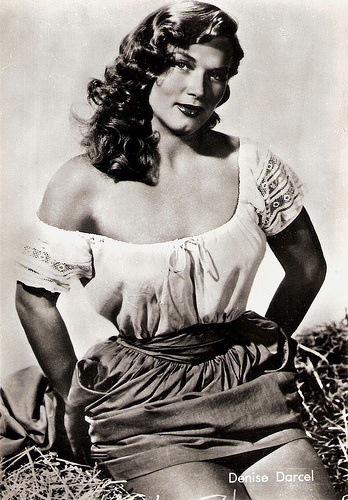
Italian postcard, no. 245.
The Most Beautiful Girl in France
Denise Darcel was born as Denise Billecard in Paris, in 1924. One of five daughters of a baker, she was educated at the University of Dijon. On VJ Day she was a passenger in an L-5 Stinson light observation aircraft to see the celebration from the air. According to Wikipedia , her friend at the time, US army pilot James Helinger Sr. was at the controls, while they flew under several bridges along the Seine and finally, under the Eiffel Tower, with the crowds below. After World War II, she was working as a shop assistant when she won a beauty contest that led to her being featured in the popular press as ‘The Most Beautiful Girl in France’. Determined to capitalise on this stroke of good fortune, she became a nightclub singer. She married a US Army captain who brought her to the United States. The marriage quickly dissolved, but Denise took the helmer Darcel and stayed in Hollywood. There she made her film debut in the war drama To the Victor (Delmer Daves, 1948), starring Dennis Morgan and Viveca Lindfors. Though her part as a bar singer was unbilled, she set male pulses racing with her rendition of Edith Piaf's signature song La vie en rose. Her breakthrough was in the Second World War film Battleground (William Wellman, 1949). The film tells the story of an infantry company trying to cope with the Siege of Bastogne during the Battle of the Bulge in World War II. Darcel played a Belgian girl with whom some American GI’s are billeted overnight. In a memorable scene she presses a baguette to her tight-fitting sweater, holds up a kitchen knife, and then slowly saws off pieces towards her bosom. Battleground won two Academy Awards: for Best Cinematography, Black-and-White (Paul C. Vogel) and for Best Writing, Story and Screenplay (Robert Pirosh). It was also nominated for Best Picture, Best Director (William A. Wellman), Best Film Editing (John D. Dunning), and Best Actor in a Supporting Role (James Whitmore). It was MGM's largest grossing film in five years, taking in a total of over $5 million in the US market alone. The film was also good for Darcel’s career. Hal Erickson at AllMovie : “She proved herself more than a beautiful face and a Gallic accent with her dramatic performance in the otherwise all-male Battleground (1949). She was then promoted as a ‘discovery’ when she co-starred with Olsen and Johnson in the 1950 Broadway revue Pardon My French.”
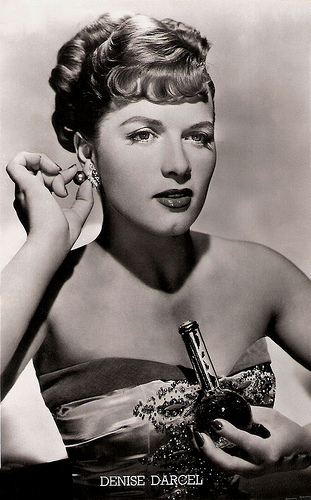
French postcard, no. 752. Photo: Metro Goldwyn Mayer.
Fifi, Gigi and Lola
Denise Darcel played characters called Fifi, Gigi and Lola in her films. Ronald Bergan in his The Guardian obituary writes that she “profited from Hollywood's ‘ooh-la-la’ conception of young, shapely French womanhood, generally inviting the adjective ‘sultry’. She made quite an impression with her ‘leg art poses’ as a sarong-wearing nurse in Tarzan and the Slave Girl (Lee Sholem, 1950) opposite Lex Barker. She co-starred with Robert Taylor in the Western Westward the Women (William A. Wellman, 1952) as a prostitute looking for a new life in 1851 California, and with Glenn Ford in the romantic comedy Young Man with Ideas (Mitchell Leisen, 1952). In 1952, she also became an American citizen. The following year she proved she looked spectacular in a swimsuit in the Technicolor musical Dangerous When Wet (Charles Walters, 1953), with ‘American Mermaid’ Esther Williams. Darcel’s most important film is Vera Cruz (Robert Aldrich, 1954) set in the Mexican War of Independence. She played Emperor Maximilian’s treacherous mistress who, along with a shipment of gold which she plans to divert, is escorted from Mexico City to Maximilian’s forces in Vera Cruz by two American soldiers of fortune – Burt Lancaster and Gary Cooper. According to Wikipedia, “the film's amoral characters and cynical attitude toward violence (including a scene where Lancaster's character threatens to murder child hostages) were considered shocking at the time and influenced future Westerns such as The Magnificent Seven, Sam Peckinpah's The Wild Bunch, and the films of Sergio Leone, which often featured supporting cast members from Vera Cruz in similar roles.”
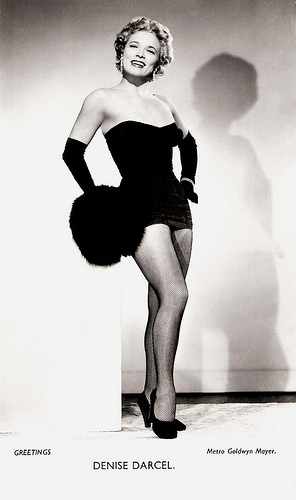
British postcard. Photo: Metro Goldwyn Mayer.
Banned in Boston
After Vera Cruz (1954), Denise Darcel only made one more film, Seven Women from Hell (Robert D. Webb, 1961), an undistinguished melodrama about a group of women prisoners in a Japanese prison camp in the Philippines. What was the reason that Hollywood stopped calling? The Telegraph : “It was rumoured that she had sealed her own fate by refusing the casting couch advances of Howard Hughes and Columbia Pictures boss Harry Cohn.” Ronald Bergan gives a less sensational explanation: “Darcel left movies for six years after Vera Cruz, living off the maintenance from her second husband, the millionaire and Washington property dealer Peter Crosby, whom she divorced in 1951. In 1958, she recorded an album of songs, Banned in Boston, which included her versions of I'm in the Mood for Love, Love for Sale and My Man, during which she occasionally reverted to French lyrics.“ She worked occasionally for television, like hosting the TV quiz show Gamble on Love (1954). At the age of 41, Darcel even became an ecdysiast (stripper), appearing in West Coast theatres in San Francisco, Las Vegas, Oakland, and Los Angeles. She retired from stripping after a few years and returned to the cabaret circuit, making a few more appearances on television. In later years she worked as a casino dealer in Las Vegas. In 1991, she was cast as Solange La Fitte in the Los Angeles 20th anniversary revival of the musical Follies, produced by the Long Beach Civic Light Opera. She would later repeat the role of Solange in 1995 for revivals in Houston and Seattle. In 2009, she was honoured with the Cinecon Career Achievement Award, presented in Hollywood at a banquet held at the Hollywood Renaissance Hotel. Prior to the ceremony, a new 35mm colour print of her film Flame of Calcutta (Seymour Friedman, 1953) was screened at the Egyptian Theatre. After the screening, at the banquet, she cheerfully announced to the audience, "I'm back". iTunes made her album, Banned in Boston, available for purchase. At the age of 87, Denise Darcel died in Los Angeles in 2011, after emergency surgery to repair a ruptured aneurysm. She married four and divorced three times. Her fourth husband, George Simpson, died in 2003. Darcel had two sons, Chris and Craig.
Scene from Battleground (1949). Source: Carole Robinson (YouTube).
Trailer for Westward the Women (1952). Source: Warner Archive (YouTube).
Official trailer for Vera Cruz (1954). Source: Neondreams (YouTube).
Sources: Ronald Bergan (The Guardian), Hal Erickson (AllMovie), The Telegraph, Wikipedia and
But this post is about Vera Cruz' female lead, Denise Darcel (1924-2011). In the late 1940s and early 1950s, the French singer and actress starred in a string of Hollywood films. Americans knew her as the sultry ‘French Bombshell’. Later she worked as a game show host, a striptease artiste and a casino dealer in Las Vegas. Indeed, ooh-la-la!

Italian postcard, no. 245.
The Most Beautiful Girl in France
Denise Darcel was born as Denise Billecard in Paris, in 1924. One of five daughters of a baker, she was educated at the University of Dijon. On VJ Day she was a passenger in an L-5 Stinson light observation aircraft to see the celebration from the air. According to Wikipedia , her friend at the time, US army pilot James Helinger Sr. was at the controls, while they flew under several bridges along the Seine and finally, under the Eiffel Tower, with the crowds below. After World War II, she was working as a shop assistant when she won a beauty contest that led to her being featured in the popular press as ‘The Most Beautiful Girl in France’. Determined to capitalise on this stroke of good fortune, she became a nightclub singer. She married a US Army captain who brought her to the United States. The marriage quickly dissolved, but Denise took the helmer Darcel and stayed in Hollywood. There she made her film debut in the war drama To the Victor (Delmer Daves, 1948), starring Dennis Morgan and Viveca Lindfors. Though her part as a bar singer was unbilled, she set male pulses racing with her rendition of Edith Piaf's signature song La vie en rose. Her breakthrough was in the Second World War film Battleground (William Wellman, 1949). The film tells the story of an infantry company trying to cope with the Siege of Bastogne during the Battle of the Bulge in World War II. Darcel played a Belgian girl with whom some American GI’s are billeted overnight. In a memorable scene she presses a baguette to her tight-fitting sweater, holds up a kitchen knife, and then slowly saws off pieces towards her bosom. Battleground won two Academy Awards: for Best Cinematography, Black-and-White (Paul C. Vogel) and for Best Writing, Story and Screenplay (Robert Pirosh). It was also nominated for Best Picture, Best Director (William A. Wellman), Best Film Editing (John D. Dunning), and Best Actor in a Supporting Role (James Whitmore). It was MGM's largest grossing film in five years, taking in a total of over $5 million in the US market alone. The film was also good for Darcel’s career. Hal Erickson at AllMovie : “She proved herself more than a beautiful face and a Gallic accent with her dramatic performance in the otherwise all-male Battleground (1949). She was then promoted as a ‘discovery’ when she co-starred with Olsen and Johnson in the 1950 Broadway revue Pardon My French.”

French postcard, no. 752. Photo: Metro Goldwyn Mayer.
Fifi, Gigi and Lola
Denise Darcel played characters called Fifi, Gigi and Lola in her films. Ronald Bergan in his The Guardian obituary writes that she “profited from Hollywood's ‘ooh-la-la’ conception of young, shapely French womanhood, generally inviting the adjective ‘sultry’. She made quite an impression with her ‘leg art poses’ as a sarong-wearing nurse in Tarzan and the Slave Girl (Lee Sholem, 1950) opposite Lex Barker. She co-starred with Robert Taylor in the Western Westward the Women (William A. Wellman, 1952) as a prostitute looking for a new life in 1851 California, and with Glenn Ford in the romantic comedy Young Man with Ideas (Mitchell Leisen, 1952). In 1952, she also became an American citizen. The following year she proved she looked spectacular in a swimsuit in the Technicolor musical Dangerous When Wet (Charles Walters, 1953), with ‘American Mermaid’ Esther Williams. Darcel’s most important film is Vera Cruz (Robert Aldrich, 1954) set in the Mexican War of Independence. She played Emperor Maximilian’s treacherous mistress who, along with a shipment of gold which she plans to divert, is escorted from Mexico City to Maximilian’s forces in Vera Cruz by two American soldiers of fortune – Burt Lancaster and Gary Cooper. According to Wikipedia, “the film's amoral characters and cynical attitude toward violence (including a scene where Lancaster's character threatens to murder child hostages) were considered shocking at the time and influenced future Westerns such as The Magnificent Seven, Sam Peckinpah's The Wild Bunch, and the films of Sergio Leone, which often featured supporting cast members from Vera Cruz in similar roles.”

British postcard. Photo: Metro Goldwyn Mayer.
Banned in Boston
After Vera Cruz (1954), Denise Darcel only made one more film, Seven Women from Hell (Robert D. Webb, 1961), an undistinguished melodrama about a group of women prisoners in a Japanese prison camp in the Philippines. What was the reason that Hollywood stopped calling? The Telegraph : “It was rumoured that she had sealed her own fate by refusing the casting couch advances of Howard Hughes and Columbia Pictures boss Harry Cohn.” Ronald Bergan gives a less sensational explanation: “Darcel left movies for six years after Vera Cruz, living off the maintenance from her second husband, the millionaire and Washington property dealer Peter Crosby, whom she divorced in 1951. In 1958, she recorded an album of songs, Banned in Boston, which included her versions of I'm in the Mood for Love, Love for Sale and My Man, during which she occasionally reverted to French lyrics.“ She worked occasionally for television, like hosting the TV quiz show Gamble on Love (1954). At the age of 41, Darcel even became an ecdysiast (stripper), appearing in West Coast theatres in San Francisco, Las Vegas, Oakland, and Los Angeles. She retired from stripping after a few years and returned to the cabaret circuit, making a few more appearances on television. In later years she worked as a casino dealer in Las Vegas. In 1991, she was cast as Solange La Fitte in the Los Angeles 20th anniversary revival of the musical Follies, produced by the Long Beach Civic Light Opera. She would later repeat the role of Solange in 1995 for revivals in Houston and Seattle. In 2009, she was honoured with the Cinecon Career Achievement Award, presented in Hollywood at a banquet held at the Hollywood Renaissance Hotel. Prior to the ceremony, a new 35mm colour print of her film Flame of Calcutta (Seymour Friedman, 1953) was screened at the Egyptian Theatre. After the screening, at the banquet, she cheerfully announced to the audience, "I'm back". iTunes made her album, Banned in Boston, available for purchase. At the age of 87, Denise Darcel died in Los Angeles in 2011, after emergency surgery to repair a ruptured aneurysm. She married four and divorced three times. Her fourth husband, George Simpson, died in 2003. Darcel had two sons, Chris and Craig.
Scene from Battleground (1949). Source: Carole Robinson (YouTube).
Trailer for Westward the Women (1952). Source: Warner Archive (YouTube).
Official trailer for Vera Cruz (1954). Source: Neondreams (YouTube).
Sources: Ronald Bergan (The Guardian), Hal Erickson (AllMovie), The Telegraph, Wikipedia and
Published on June 29, 2013 23:00
Paul van Yperen's Blog
- Paul van Yperen's profile
- 13 followers
Paul van Yperen isn't a Goodreads Author
(yet),
but they
do have a blog,
so here are some recent posts imported from
their feed.



